Biography Online


Pele Biography
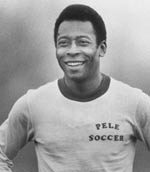
“I was born for soccer, just as Beethoven was born for music.” – Pele
Pele was born Edson Arantes do Nascimento on 23 October 1940 in Três Corações, Minas Gerais, Brazil. He was named after the American inventor Thomas Edison (his parents removed the i). In his childhood, he gained a nickname ‘Pele’ – after he mispronounced the name of a goalkeeper ‘Bile’ – Initially Pele disliked it and complained, but the more he complained, the more it stuck. Pele has no meaning and was intended as an insult, though later it was found that the word Bilé is Hebrew for “miracle.”
Pele grew up in poverty in São Paulo. He was taught to play football by his father (who used to play football), but often he had to practise with a sock stuffed with newspapers because he could not afford to buy a football. As well as playing football, he worked as a waiter in local tea shops.
In his youth, Pele played in indoor leagues, and this helped increase his speed of reactions. He rose through the youth leagues and at the age of 15 was signed by Santos FC. He was soon marked out as a future star. By the age of 16, he was the top scorer in the Brazilian league and received a call up for the Brazilian national side. Interest was such that the Brazilian President declared Pele a national treasure to prevent him being bought by foreign clubs such as Manchester United.
Pele’s World Cups
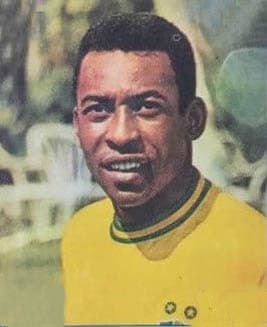
1970 World Cup

Style of play
Pele was relatively short at 5″ 8′, but he more than compensated in terms of speed, power, agility and strength. He was superb with both feet, powerful in the air, great timing and accuracy and an extraordinary perception of the game. He could mesmerise defenders with his eyes and send them the wrong way. He had a scoring ratio of 0.94 goals per game and often rose to the big occasion, scoring at crucial moments in big games. Whilst very competitive, he was also considered to be a fair player with good sense of sportsmanship. A good example was his warm embrace of Bobby Moore, the England caption after England’s defeat in the 1970 World Cup. It is sometimes held up as an embodiment of sportsmanship. Without any doubt, he is universally regarded as the greatest player of the twentieth century – if not all time. He is one of the few sportsman like Muhammad Ali and Usain Bolt, who transcend their sport to become a global icon. French footballer Michel Platini said of Pele.
“There’s Pelé the man, and then Pelé the player. And to play like Pelé is to play like God.
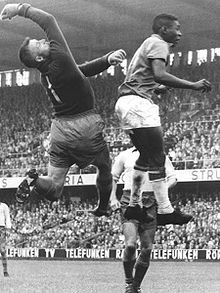
In the domestic league, Pele made his debut for Santos aged just 16. He played for Santos in the Brazilian league from until the 1972-73 season.
Pele finished his career in the lucrative US league. In 1975, he signed for New York Cosmos and played three seasons. He led the New York Cosmos to the US title in 1977 – the year of his retirement.
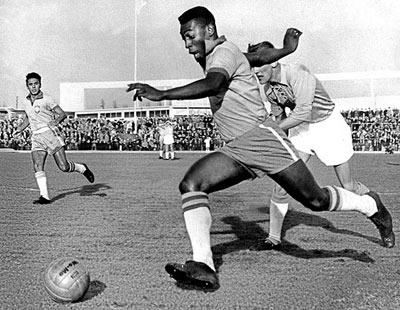
Personal life
Pele was married three times and had several children, some out of wedlock. In 1970, he was investigated by the authoritarian Brazilian government for suspected sympathy to left-wing political prisoners. Pele was investigated for handing out leaflets calling for the release of political prisoners. After the investigation, he did not get involved in politics again.
After retiring has gone on to be a great ambassador for football and sport in general. In 1992, Pelé was appointed a UN ambassador for ecology and the environment. He was also appointed a UNESCO goodwill ambassador. He is not only one of the most gifted footballers of his generation, but, also a mild-mannered man who used his fame and prestige for a positive effect.
Citation: Pettinger, Tejvan . “Biography of Pele”, Oxford, UK. www.biographyonline.net. Last updated 8 March 2020. Originally published 18 April 2010.
Some Highlights of Pele’s Career
- Athlete of the Century , by Reuters News Agency: 1999
- Athlete of the Century , elected by International Olympic Committee: 1999
- UNICEF Football Player of the Century : 1999
- TIME One of the 100 Most Important People of the 20th Century : 1999
- FIFA Player of the Century : 2000

Pele – autobiography at Amazon
Related pages
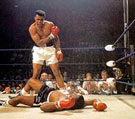
- Tournaments
Home › Players › Pelé
B orn on October, 23, 1940 in Minas Gerais, Brazil, Edson Arantes do Nascimento would become more commonly known around the world as Pelé. His father, João Ramos do Nascimento, played professional soccer himself, but his career never brought him much in the way of money. As the legend goes, Pelé’s family could not even afford to buy a ball for him, so he stuffed socks and molded them into the shape of a ball to kick around.
Basic facts
Birth: 1940 Death: 2022 Country: Brazil Position: Forward
Santos FC (1956-1974) New York Cosmos (1975-1977)
Club football: 694 matches, 650 goals National team: 92 matches, 77 goals
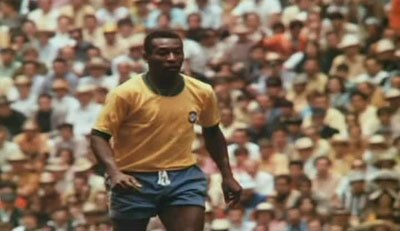
Early career
Although he continued to struggle financially in São Paulo, working a variety of jobs to help his family, the young Pelé found his true talent on the field. Under the tutelage of his father and a former national team player named Waldemar de Brito, Pelé began to mature as a player on the Bauru Athletic Club juniors. Coach de Brito recognized his ability and recommended him for a tryout with Santos FC. The team’s management agreed with de Brito’s assessment and signed Pelé in June 1956. A mere three months later, Pelé scored a goal in his debut match. Although few people knew it at the time, this foreshadowed the success to come in the rest of Pelé’s professional career.
Stardom of a youngster
Only a short year later, Pelé topped the list of scorers in the league. His performance, at the tender age of 17, caught the attention of the national team. He would not disappoint. In his first appearance on the world stage, he scored key goals in both the semifinal and the final match of the 1958 World Cup to win it for Brazil . At this point, he had achieved superhero status in Brazil and became a household name around the world. The Brazilian government honored him as a “national treasure,” which elevated his status at home, but also prevented him from taking advantage of offers a broad.
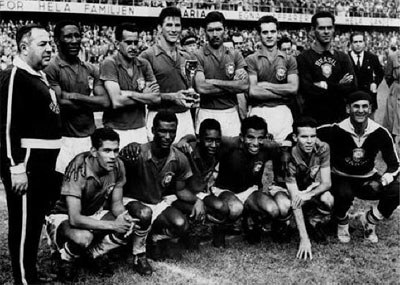
Struggle with injuries
On an individual level, the next two World Cups turned out disappointing due to injuries. The Brazilian side still won the tournament in 1962, but they fell way short in 1966 without their star player—they were eliminated in the group stage. During this era, though, Pelé continued to excel on his club team, Santos. Consistently a top scorer, he often faced teams who had altered their play specifically to deal with the threat he posed. Despite this, he still managed to score 60 goals in the 1964 season and 101 goals the year after that.
Retirement and comeback
By the time 1970 rolled around, Pelé had reportedly decided to hang up his hat and leave while he was on top. However, he was eventually coaxed into playing one last World Cup for Brazil in Mexico on what many consider as the best team in history. Pelé contributed to Brazil’s tournament win with goals and several important assists, earning himself the Golden Ball award for his play. Pelé continued with the Brazilian team for about another year, finally calling it quits in 1971. A few years after that, he said goodbye to his fans at Santos, too. His days as a player were still not over, though.
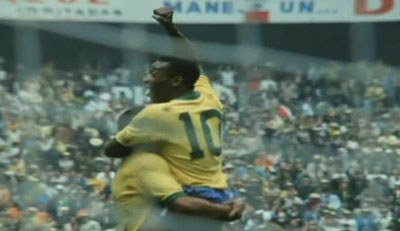
Late career
Although he had long said that he would only ever play for Santos, he could not resist answering the call from the New York Cosmos in 1975. The North American Soccer League (NASL) represented a significant step down in terms of the level of play that Pelé was accustomed to. The burgeoning league benefitted greatly from this ambassador of the game, though, and ticket sales rose. The American public, largely unfamiliar with the game, took notice. Pelé led the Cosmos to a championship before retiring for good, an event marked by an exhibition match between his adoptive New York team and Santos.
Legacy and life after the football career
At the time of his retirement in 1977, Pelé had amassed a series of seemingly unbreakable records. He had racked up a total of 1,283 goals in 1,363 matches, making him the top scorer in Brazilian national team history and FIFA history. Just as impressively, he managed to pull off 92 hat-tricks. He also set a record for the most FIFA World Cup wins for an individual, with three medals to his name. His early years should not be overlooked, though. The young Pelé burned bright, becoming the youngest player to score a hat-trick and the youngest player to score in a World Cup final match. Retirement saw “O Rei” go on to campaign for a variety of causes, including poverty reduction, anti-corruption movements, and environmental protection. He also received an honorary knighthood, served as the Minister of Sport in Brazil, and assumed the role of a UNICEF Goodwill ambassador. Of course, he never stopped promoting the game throughout the world, including FIFA events and Olympic ceremonies. Perhaps most memorable of all, he popularized the phrase “the beautiful game” as shorthand for the game he loved so much. Generations of enthusiasts have imagined themselves playing with the grace and beauty of “The Black Pearl.” He could strike the ball with astonishing accuracy or flick it off to a teammate through a thick web of defenders’ legs. His iconic goal-scoring bicycle kick in Belgium in 1968 sent young players from all over rushing outside for hours of painful practice. What dazzled many of his fellow players was his uncanny ability to work his way out of almost any situation with sheer skill. For those who have wondered about the origin of the name “Pelé,” the answer proves elusive. Some have claimed that it came from Pelé’s poor pronunciation of the name of a goalie he admired named “Bilé.” According to this version of events, his teammates half-mockingly gave him the name “Pelé” and he could not shake it. Pelé himself has never given a definitive account of how he got the name. In fact, he claimed he never cared for it much. Like so much else in this superstar’s life, though, the magic lies not in minute biographical details or trivia, but in the legacy that Pelé left on the field. Pelé passed away in december 2022, at the age of 82.
By Rosa Nelson
More articles
› Rivellino – King of the Park › Lev Yashin – The Black Spider › Alfredo Di Stéfano – The Blond Arrow
References: http://www.biography.com/people/pel%C3%A9-39221#more-world-cup-titles http://www.telegraph.co.uk/sport/football/world-cup/10874465/How-and-why-Peles-mystique-and-reputation-as-the-worlds-greatest-ever-footballer-has-been-overhyped.html http://www.goal.com/en/news/60/south-america/2010/10/21/2176031/70-facts-about-brazil-legend-pele Image source: Image sources: 1, 3 FIFA – World Cup Official Film 1970 2 Scanpix
Football Players
- Marco van Basten
- Franz Beckenbauer
- David Beckham
- Dennis Bergkamp
- George Best
- Zbigniew Boniek
- Bobby Charlton
- Johan Cruyff
- Alfredo Di Stéfano
- Steven Gerrard
- Gheorghe Hagi
- Ruud Gullit
- Thierry Henry
- Michael Laudrup
- Diego Maradona
- Gerd Müller
- Michel Platini
- Juan Román Riquelme
- Arjen Robben
- Hugo Sánchez
- Hristo Stoichkov
- Hakan Şükür
- George Weah
- Zinedine Zidane
- Gianfranco Zola
Skills, charisma, mysticism: The life of football legend Pele
The world bids farewell to one of the greatest footballers ever seen.
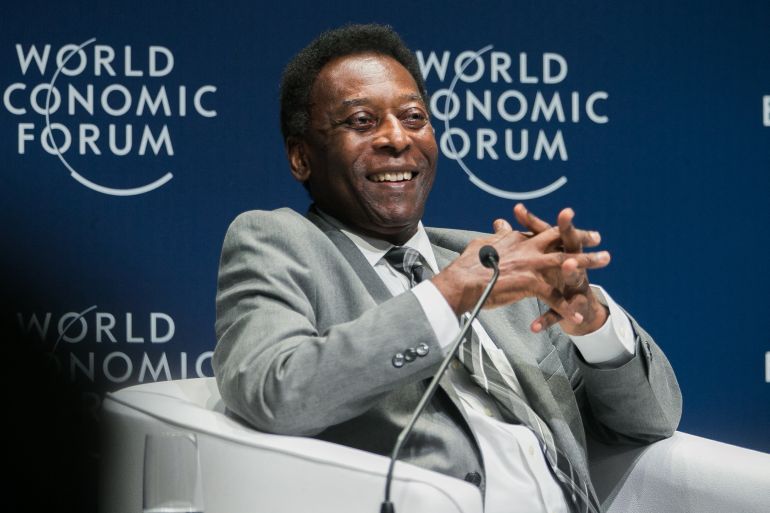
Santos, Brazil – A famous sports writer once said that “if Pelé had not been born a man, he would have been born a football”.
Pelé – real name Edson Arantes do Nascimento – one of the greatest footballers the world had ever seen, died on Thursday at the age of 82.
Keep reading
Brazilian football legend pele dies at age 82, pele, brazilian football ‘phenomenon’, leaves unparalleled legacy, photos: ‘the king’ pele, a lifetime of football memories.
Born in the state of Minas Gerais in 1940, Pelé’s family moved to a nearby city called Bauru looking for a better life. He grew up in poverty and his parents could not even afford a football. An old sock filled with newspapers was the first “ball” his magical feet kicked but it was enough for him to fall in love with the game and for people to start noticing he was different.
When Pelé was 15, a local coach, Waldemar de Brito, took him to play for the football club Santos. Upon arriving in the city that shares the name with the club, Brito told the coach, “This kid will be the best in the world.”
Within minutes, the coach was impressed with Pelé and signed him on the spot. This was 1956. Two years later, Pelé would be in Sweden, spearheading Brazil to a World Cup title, the first of six for the team. He scored two goals in the final against Sweden. He was still 17.
At the final whistle, the wonder kid fainted on the field while being carried by the celebrating crowd.
Pelé was famously easy-going, kind, joyful, and a reliable friend.
“Pelé was always a very nice guy. We would spend so much time talking. He didn’t have any star attitude,” Didi, 84, one of Pelé’s oldest friends and his barber of 55 years, told Al Jazeera.
“I tell my grandchildren that I had one client more famous than anyone else. This is a man who is known more all over the world than Coca Cola. So I feel proud of it and it’s very rare for someone to have a client like this.”
Pelé had a certain way of speaking Portuguese, something he would turn into a trademark. He would constantly finish his sentences with “entende?” which means “understand?”.
It seems he always wanted to make sure to facilitate conversations, just like he would smooth out his teammates’ game.
In addition to skills and charisma, a certain mysticism always surrounded the character of the King of Football. Pelé was from a city called Três Corações, which translates to Three Hearts.
One of his many famous quotes, made at his last match ever played in 1977 in New York, was honouring children and with his limited English, he just said “love, love, love.”
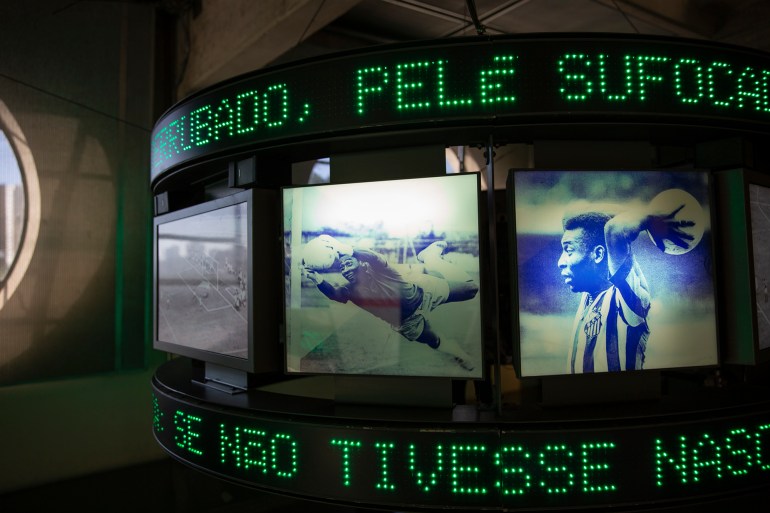
On the pitch, Pelé became an instant celebrity following the 1958 World Cup triumph. Upon returning to Brazil, he helped Santos build a dynasty, winning 25 titles in the 1960s. Despite being world-famous, Pelé kept living a down-to-earth life in Santos. He would share a guest house with other players and cycle around the city.
“The pay was pretty bad but he did it for love of the game and we had so much fun,” Carlos “Lala”, 86, a goalkeeper and Pelé’s former Santos teammate, told Al Jazeera.
Despite being a widely diverse country ethnically, Brazil is not often represented by people of colour. So having someone Black as its biggest celebrity and star had a cultural impact on the country.
Aside from being the world’s best footballer, Pelé also ventured into showbusiness. A lover of music, he recorded an album with Brazilian legendary singer Elis Regina and acted in a handful of movies, making him a pop star as well.
In 1962, Brazil won a second successive World Cup with an injured Pelé supporting the team.
It was in 1970, at the first World Cup broadcasted in colour, that Pelé put the cherry on top of his football legacy. The team that had Clodoaldo, Rivelino and Tostão, put in one of the most celebrated World Cup performances in history.
In the final, a 4-1 win over Italy, Pelé scored a header – the team’s opening goal – that some people said he managed by freezing midair. He celebrated the goal in his typical manner: Jumping and punching the air.
“I told myself before the game that Pelé is made of skin and bones just like everyone else. But I was wrong,” said Tarciso Burnigch, the Italian defender appointed to mark Pelé in the final.
That was Pelé’s 12th and final World Cup goal.
In 1969, he had become the first player to score 1,000 goals. The 1,000th goal was at the Maracanã, in Rio de Janeiro, known as the Mecca of Football.
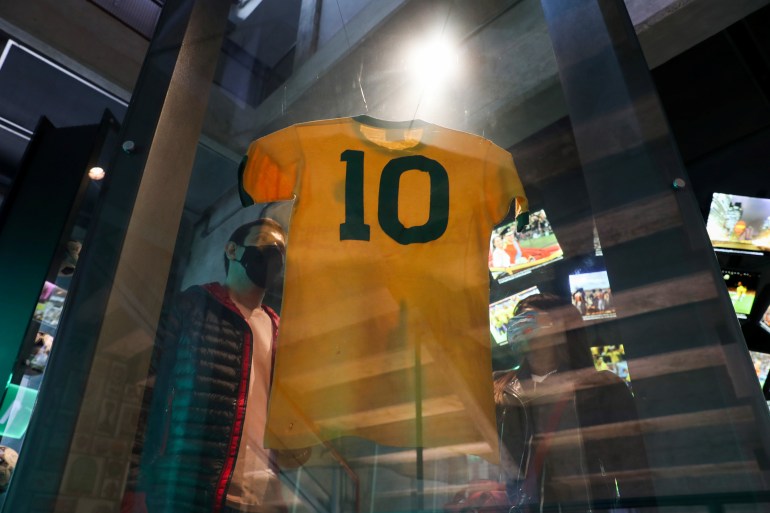
In 1974, he left Santos and played his final years in New York, at a club called Cosmos.
It was the only team he played for other than Santos and Brazil’s national side.
“As we [the security team] were always with the team, traveling, at the games, we had a lot of contact with them, so we developed a friendship,” Pedro de Liberato, Pele’s security guard, and then his neighbour, told Al Jazeera.
“Pelé was always very joyful, always joking with people,” the 90-year-old added.
Pelé wore the number 10 jersey but he did not know which number he would have and was assigned 10 randomly.
The number 10 jersey has since then become associated with the world’s best – Maradona, Roberto Baggio, Zinedine Zidane and Lionel Messi are just some of them who have worn it.
Pelé retired after playing 1,363 games, winning 37 titles, scoring 1,281 goals, including 92 career hat-tricks.
He spent his post-football life involved in social activism, including being a UNESCO goodwill ambassador.
In 1995, he took public office as minister of sports, introducing the legislation that grants players their own rights after a certain age. Pelé also commented on games for television.
In recent years, Pelé struggled with his health. Aside from battling cancer, he also suffered from severe hip pain and spent most of his last years in a wheelchair.
Pelé obituary: The king of football who came to define Brazil
Sport Pelé obituary: The king of football who came to define Brazil
No single word carries greater connotations of the beautiful game than Pelé.
Born Edson Arantes do Nascimento, but known around the world as Pelé, the greatest player of his generation has died after a battle with colon cancer and a respiratory infection in São Paulo. He was 82.
Hailed by many in Brazil as "O Rei" ("The King"), and by FIFA as "The Greatest", Pelé left an indelible mark on world sport with an incredible facility for scoring goals on the biggest stage.
The true number of goals Pelé scored — officially 1,279 from 1,363 games — may be questioned.
But whether that number is exact or not, his status as one of the most iconic and potent strikers of all time is unmatched.
His role in shaping the cultural identity of Brazil as one of the sport's first truly global superstars is immeasurable.
For many, Pelé came to define football. And as a result, he cemented Brazil's association with the sport.
Pelé led the affirmation that Brazil should be idolised as a beacon of footballing excellence, his exploits at three World Cups helping a nation struggling with what poet Nelson Rodrigues called a "mongrel complex" to develop its sense of self on the world stage.
It was a feat that led to him being revered by all.
"I was never one for idols. That said, I'm a good Brazilian and so it's only inevitable I look up to Pelé," 1994 World Cup winner Romário said.
"He's like a God to us — well, he is to me, anyway.
"I think instead of calling the game football, we should call it, Pelé."
Football's greatest icon
There is no more grating topic than which player is the greatest of all time, but there is no denying that Pelé was one of the best players to ever grace a football pitch.
"The greatest player in history was [Alfredo] Di Stéfano," said Hungarian legend Ferenc Puskás of his former Real Madrid teammate, with one caveat.
"I refuse to classify Pelé as a player. He was above that."
Former Brazil star Dunga told FIFA that Pelé was "a myth … a myth you can't discuss. Pelé did things that are not human."
Dutch legend Johan Cruyff said he simply "surpassed the boundaries of logic."
Blessed with a mesmeric touch with feet, head, chest and thighs, incredible balance, pace, and a leap that belied his relatively slight 173-centimetre frame, Pelé was a player who had it all.
His record of 77 official goals for the Brazilian national team was only equalled at this year's World Cup by Neymar Jr.
For much of his career, most Brazilian football fans only knew Pelé through listening to radio commentary of his exploits on the pitch.
It was the advent of television, timed to coincide with his World Cup exploits, that ensured the world saw him at the peak of his powers, winning three of the four World Cups he played in to enshrine his legacy.
When shown on colour at the 1970 World Cup, Pelé was elevated onto a different plain, the vibrancy of Brazil's iconic yellow shirts cutting swathes through their opponents in glorious technicolour.
Before Pelé was included in Brazil's 1958 World Cup squad as a 17-year-old, his coach at Santos, Lula, told reporters he could "no longer be compared to anyone else because he possesses all the qualities of the ideal football player".
And he showed it too, racking up honours with Santos and Brazil at a rate that has been unsurpassed throughout history.
The child genius, thrust into a man's game aged just 15, was the complete player as a teenager — and only got better with age.
"He was such a talented player with great control and vision," England great Sir Bobby Charlton recalled.
Even Diego Maradona, the greatest of his era, described him as an "awesome player".
Pelé was named a joint FIFA player of the century with the Argentine legend, a man so diametrically opposed to him away from the pitch.
Their poetic brilliance with the ball and the number 10 on their shirts was their only common ground.
From the favelas to national icon
Pelé's path to sporting immortality started the same way as many other South American footballers of his generation.
Born in poverty in the provincial town of Três Coroções, the young Pelé played shoeless on gravel pitches with a makeshift collection of rags to use as a ball.
His father, Dondinho, a former player with Fluminense, and ex-Brazil international Waldemar de Brito, coach of local side AC Bauru — where Pelé moved with his family as a child — recognised his talent from an early age, promoting him to the senior side aged just 15.
He was taken to trial with São Paulo giants Santos as a 16-year-old, starting a playing relationship that would last over 1,200 games over 17 years, almost his entire professional career.
He started, as you might expect, with a goal off the bench.
Pelé's arrival at Santos coincided with the general rise of the club which, off the back of 58 goals from Pelé, won the Campeonato Paulista — the São Paulo state league — for the first time in 20 years. Brazil was still three years away from hosting a true national league competition, but when that was inaugurated, Santos and Pelé won that too.
Pelé helped Santos to 10 Paulista titles between 1958 and 1973 to go with six national Serié A crowns and two Copa Libertadores, the South American version of the Champions League.
Some have since questioned whether Pelé needed to play in Europe to be considered one of the greats, but that is a lazy, ill-advised assumption, discounting the extraordinary strength of South American football at the time.
Santos proved their class by beating Benfica to win the 1962 Intercontinental Club Cup, removing any doubt among the uneducated.
Pelé scored five goals in that 8-4 aggregate victory, which led to a national holiday being declared in Brazil.
It's not that there was no interest from Europe: Real Madrid, Juventus, Manchester United and Inter Milan were all suitors.
Internazionale were to get closest, even managing to sign Pelé in 1958, only to be forced to tear up the contract after an outcry at home.
Brazilian president Jânio Quadros even went as far as to declare Pelé a national treasure to prevent any future attempts to deport his extraordinary talent.
Pelé spent his entire club career with Santos, bar a three-year stint with the New York Cosmos in quasi-retirement, as he eschewed the lure of big-money moves to Europe.
The World Cup king
Pelé's greatest impact on world football may be his role in establishing the mythology of Brazilian footballers as vehicles of flair and flamboyance.
Pelé was just 17 at his first World Cup, the 1958 tournament in Sweden, scoring six goals in total for the Seleção, including two in the final.
By having such a huge impact at the world's biggest tournament, Pelé became synonymous with the World Cup.
It was the first of back-to-back World Cup titles for Brazil that established the country as a true footballing nation and made O Jogo Bonito — the beautiful game — part of the sport's global lexicon.
In the 1958 final, when Brazil beat Sweden 5-2, Pelé scored one of the great World Cup goals.
In the 90th minute, Pelé controlled a ball played from inside the Brazil half on his chest and, in one motion, let it drop and backheeled it to a teammate, only to then race into the penalty area to receive the cross.
Diving away from the ball's flight, Pelé headed it inside the near post, sparking scenes of delirium that appeared to overwhelm the young star into fainting.
"After [Pelé's] goal, even I wanted to cheer for him." bullish Sweden defender Sigge Parling told FIFA, remembering that extraordinary second goal.
He was picked up and paraded in front of a Swedish crowd that had incredibly turned on its own players, so in awe of what it was witnessing.
A brutal examination by some practitioners of the worst of the era's tackling techniques limited Pelé to just two games in 1962 through injury as Brazil retained its title, and the same issue stymied the Brazilians' quest for a third straight title in England in 1966.
However, normal service was resumed with a stunning triumph in 1970, when Brazil beat Italy 4-1 in the final.
Pelé again led the line with more sumptuous performances in Brazil's famous yellow shirt, which occurred in front of a worldwide audience for the first time via colour television, helping affirm a global idolisation of the team that remains to this day.
"I told myself before the game, 'He's made of skin and bones just like everyone else'," Italy defender Tarcisio Burgnich said after that final.
"But I was wrong."
The global brand of Pelé
Pelé was a stunningly prolific goalscorer. Even if the mathematics used to calculate his "official" total may not stand up to scrutiny, his profligacy took on a life of its own.
Santos looked to profit from Pelé's celebrity with hundreds of friendly matches around the world — including a 1972 trip to Sydney, where Santos drew 2-2 with the Socceroos at Moore Park in front of 31,755 people.
Those friendlies were important financially but were just as important socially.
In 1969, Santos toured Nigeria, then in the grips of a brutal civil war — which halted for 48 hours to allow Pelé and Santos to play twice against the Nigerian national team.
That was also the year that Brazil had become obsessed with Pelé scoring his 1,000th career goal, O Milesimo.
To understand the impact it had on the public consciousness in Brazil, you need look no further than what it displaced from the front page the day after he scored it.
While most press around the world on November 20, 1969 had coverage of the Apollo 12 Moon landing, in Brazil that news was shared with the events that took place at the Maracanã the previous afternoon, as Pelé slotted home from the penalty spot against Vasco de Gama.
In a country obsessed with football, Pelé transcended the sport, featuring as the subject of songs and poetry and appearing in telenovelas and movies, including the domestic flick Os Trombadinhas and, later, Escape to Victory.
Pelé knew his value and, unusually for the time, had acquired an agent and manager by the late 60s to ensure he could maximise his earning potential, even trademarking his name.
His stardom was such that he was even credited with revitalising the North American Soccer League when signing for the New York Cosmos in 1975.
Pelé's three years at the Cosmos, for which he was paid $US4 million, helped reinvigorate the league and saw him play matches in front of sold-out crowds across the country.
When he retired in 1977, the Brazilian press said even the sky cried, as torrential rain fell on a friendly between the Cosmos and Santos.
The league never recovered, limping on until being disbanded in 1984.
'Honoured but ultimately distant'
Pelé is not beyond criticism.
In a 2021 eponymous Netflix documentary, he recounted how his various affairs contributed to the failure of his first marriage, to Rosemeri dos Reis Cholbi.
He was also criticised for remaining largely apolitical during a time of deep upheaval in Brazilian politics.
During the 1970 World Cup, Brazil was run by a military dictatorship under president General Emílio Garrastazu Médici.
Pelé said in his documentary that he felt only "relief" when Brazil won the title in 1970 as opposed to any joy, such was the pressure being put on the team back home.
It was during that time when the military junta used torture and killings to crush protests, and that same government used Pelé's image to help promote a unified country.
Pelé went on to become his country's extraordinary minister for sport in 1994, attempting in part to rein in the chaotic state of the finances of the nation's domestic football clubs, and remained a figurehead for Brazilian football right up until his death.
His legacy will be that of Brazil's favourite son.
But football historian David Goldblatt, in his footballing opus The Ball is Round, noted that even Pelé's nickname carried a degree of detachment.
"Pelé was O Rei — 'The King', honoured but ultimately distant, of another world," he wrote.
"The King was and is revered but [Pelé's 1960's contemporary] Garrincha was loved."
Whether Brazil loved its king or simply stood back in awe, his contribution to both the nation and the global game can never be forgotten.
- X (formerly Twitter)
- FIFA World Cup
- Skip to main content
- Keyboard shortcuts for audio player
Pelé, who made soccer 'The Beautiful Game,' dies at 82
Catherine Osborn

Pelé appears at Pelé: The Collection, presented by Julien's Auctions in London on June 1, 2016. Neil Hall/Anadolu Agency/Getty Images hide caption
Pelé appears at Pelé: The Collection, presented by Julien's Auctions in London on June 1, 2016.
RIO DE JANEIRO — The soccer star Edson Arantes do Nascimento — known around the world as Pelé — has died at 82. He'd been battling complications from colon cancer and had been admitted into a hospital in São Paulo last month.
One of his daughters, Kely Nascimento, announced his death on Instagram — showing a picture of his family's hands holding his hand. "Everything we are is thanks to you. We love you infinitely. Rest in peace."
Pelé was soccer's global face for decades and is regarded by many as its best player of all time . He rose from humble beginnings in rural Brazil to eternalize a powerful and creative style of play.
"He walks on the field with one of those irresistible and fatal authorities. I would say that of a king," penned Brazilian writer Nelson Rodrigues upon watching a 17-year-old Pelé play in 1958.
Pelé went on to reign over global soccer for the next 20 years, including a stint for the New York Cosmos, the only team outside Brazil for which he ever played.

Brazilian forward Pelé dribbles past a defender during a friendly match in 1960. AFP via Getty Images hide caption
Brazilian forward Pelé dribbles past a defender during a friendly match in 1960.
Making soccer art
It was in 1958 , during one of the first televised World Cups, that Pelé debuted to thrilled global audiences as a young striker.
In the tournament's final game against Sweden, he flicked the ball high over his defender's head and smashed it into the net. He then headed in another goal, cementing a victory (at 17, he remains the youngest player to score in a World Cup). At the time, Brazil's economy was booming, and the team's exuberance became a symbol of the country itself.
"The whole world cares about football, and the biggest footballer was Brazilian," says Brazilian sports commentator Marcelo Barreto. "I think we related to Pelé because of his creativity."

Pelé visits Olympic Stadium in Barcelona, Spain, on Sept. 2, 2017. Xavi Torrent/Getty Images hide caption
During a career including three World Cup titles — more than any other player in history — and over 1,200 goals, Pelé became known for his flair and unpredictability. He would blow past his opponents by dribbling the ball off their shins. He was also a playmaker and one of the early pioneers of the bicycle kick, a leap upward at an airborne ball to rocket it backward.
Barreto says that Pelé's athleticism could have easily earned him stardom in track and field as well as soccer. "He could run 100 meters in, like, 11 seconds. He could kick with the right foot and the left foot. It was like his strength was at the service of the beauty of the game."

From a young age, Pelé's greatness was clear. Kids surrounded the Brazilian superstar to get an autograph. Central Press/Getty Images hide caption
From a young age, Pelé's greatness was clear. Kids surrounded the Brazilian superstar to get an autograph.
A rise from humble roots
Pelé grew up watching his father play professionally in a small town in southeastern Brazil. He played in the streets, where he earned his nickname, and then in youth leagues. There, a former Brazilian national team player coached him and oversaw his move at age fifteen to the club Santos, near São Paulo.
At the gym at Santos, he added judo and karate to workouts. His teammate Mengálvio Figueiró said most players as talented as Pelé didn't worry so much about physical conditioning, but Pelé "ran to the front of the line to do laps around the field."
Pelé said in an interview to CNN that he tried to follow a lesson from his father: "If you be focused, if you have good health — nobody's gonna stop you."

Pelé and his New York Cosmos teammates line up before their NASL semifinals match against the Rochester Lancers at Giants Stadium on Aug. 24, 1977. George Tiedemann/Sports Illustrated via Getty Images hide caption
As he began to rack up wins for Santos alongside a powerful attacking squad, Pelé's career also coincided with a golden age of Brazilian sportswriting, according to journalist Andrew Downie. The brothers Nelson Rodrigues and Mario Filho, known also for playwriting and political journalism, relished covering soccer matches, especially Pelé's, with "beautiful and acerbic wit," says Downie. "People would buy the newspaper to see what they were saying" and pack stadiums to see what would happen next.
One Pelé goal that blew past six defenders and inspired a near-two-minute standing ovation in Rio de Janeiro's Maracanã stadium moved a sportswriter not only to recount it in newsprint, but also to arrange for a commemorative plaque to be affixed to the sporting arena, birthing a Brazilian expression for any gorgeously executed feat: "plaque-worthy goal."
Pelé was named Athlete of the Century by the International Olympic Committee, Player of the Century by the International Federation of Football History and Statistics, and joint Player of the Century by FIFA. He is an honorary knight of the British Empire and served as a UNESCO Goodwill Ambassador and Brazil's Minister of Sports, where he oversaw new legislation on labor rights for athletes.

Pelé, seen here in Canada on May 10, 1978, had an infectious smile and always loved to joke around. Boris Spremo/Toronto Star via Getty Images hide caption
Symbolizing the world's game
Over the course of his life, Pelé was devoted to spreading the image of soccer's power to transcend national borders.
One of the most famous photos in sports history is of his embrace of English defender Bobby Moore at the 1970 World Cup . Santos attracted fans playing exhibition games across the world, and Pelé proudly recounted that world leaders like Nelson Mandela and Desmond Tutu were among his admirers. In the late 1970s, he played for the New York Cosmos, boosting American interest in the game. On the day Pelé retired, he reiterated his positive message to a packed stadium, asking fans to repeat the word "love" with him three times.
But even as he championed the idea of soccer as a unifier, Pele's life intertwined with racial and political divides at home. One of his biographers, Angelica Basthi, said after Brazil lost the 1950 World Cup with a Black goalkeeper, a racist narrative spread that Black soccer players were unreliable.
Until the 1958 victory, that is, when "people started to see Black players through the talent of Pelé."
Even so, Black Brazilian civil rights leaders would later criticize Pelé for ignoring their calls to denounce racism in the country, Basthi said: "He bet on an earlier narrative" that his success disproved there were racial barriers. Pelé faced criticism for other actions of his off the field, including a fierce battle against legally recognizing one of his daughters.
He often responded to critiques by saying that Pelé, the player, was separate from Edson, the man, who was flawed.
Marcelo Barreto says that today, Brazilians are starting to judge athletes more for the political implications of their actions. "We are slowly beginning to understand that it's not only soccer. That soccer is not separated from our society, from our life."

Young or old, Pelé felt right at home on the field with a ball close by. He was a champion and cheerleader for the game. Keystone/Getty Images hide caption
Young or old, Pelé felt right at home on the field with a ball close by. He was a champion and cheerleader for the game.
In terms of athleticism, Barreto says, Pelé continues for many Brazilians to represent the country's capacity for greatness.
As the pace, geography, and gender of the world's best soccer has shifted since Pelé's heyday, it continues to entrance billions.
Pelé accompanied the careers of young Brazilian and international players until the end of his life. In 2011 he said, "I think it will be, always, the beautiful game."
- Brazilian soccer
10 Things You May Not Know About Pelé
From the origins of his name to how he played his final pro game for both teams, here are some facts about the Brazilian soccer star.
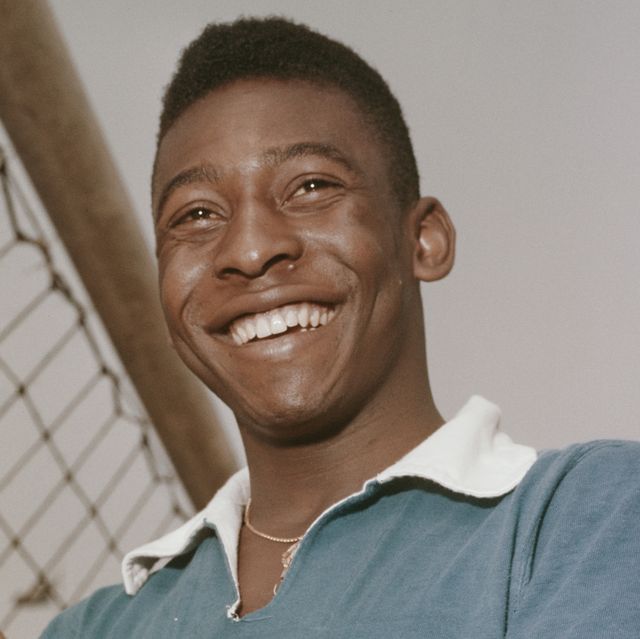
We may earn commission from links on this page, but we only recommend products we back.
Thus began Pelé's storied career, and by the time he played his final professional game in 1977, he’d netted over 1,280 career goals as part of Brazil’s Santos Football Club and the New York Cosmos. Although he was widely considered to be the greatest soccer player of all time, here are 10 things you might not know about Pelé:
He was named after Thomas Edison
As Pelé explained in a September 2014 tweet , his father João Ramos, a soccer player also known as Dondinho, and mother Dona Celeste named him Edson, after Thomas Edison . ”Electricity had just been introduced to my hometown in Brazil when I was born,” wrote the Três Corações native. First nicknamed “Dico” by his family, Pelé later explained that the moniker by which he’s currently known worldwide “really bugged” him at first.
“I was really proud that I was named after Thomas Edison and wanted to be called Edson,” he wrote in a 2006 Guardian piece . “I thought Pelé sounded horrible. It was a rubbish name. Edson sounded so much more serious and important.” Although the sports star added he “can never be 100 percent certain about the origin,” the most probable explanation is that the nickname was given to him by classmates because he mispronounced the name of one of his dad’s soccer teammates: Vasco de Sao Lourenco, a goalkeeper affectionately known as "Bilé."
“So when someone said, "Hey, Pelé," I would shout back and get angry. On one occasion I punched a classmate because of it and earned a two-day suspension,” he wrote. “Now I love the name — but back then it wound me up no end.”
He got creative when he couldn’t afford a soccer ball or shoes
Growing up in poverty, Pelé practiced his dribbling skills with a sock stuffed with rags when his family couldn’t afford to buy him an actual soccer ball. When he was 6, the family moved to a larger town in southern Brazil, where he shined shoes and sold roasted peanuts outside movie theaters to earn money for a soccer ball. Unable to afford shoes himself, he also frequently played barefoot, and his friends eventually formed a team called the Shoeless Ones. Later, barefooted games played in vacant lots became known as “ pelada ,” believed to be named after Pelé.
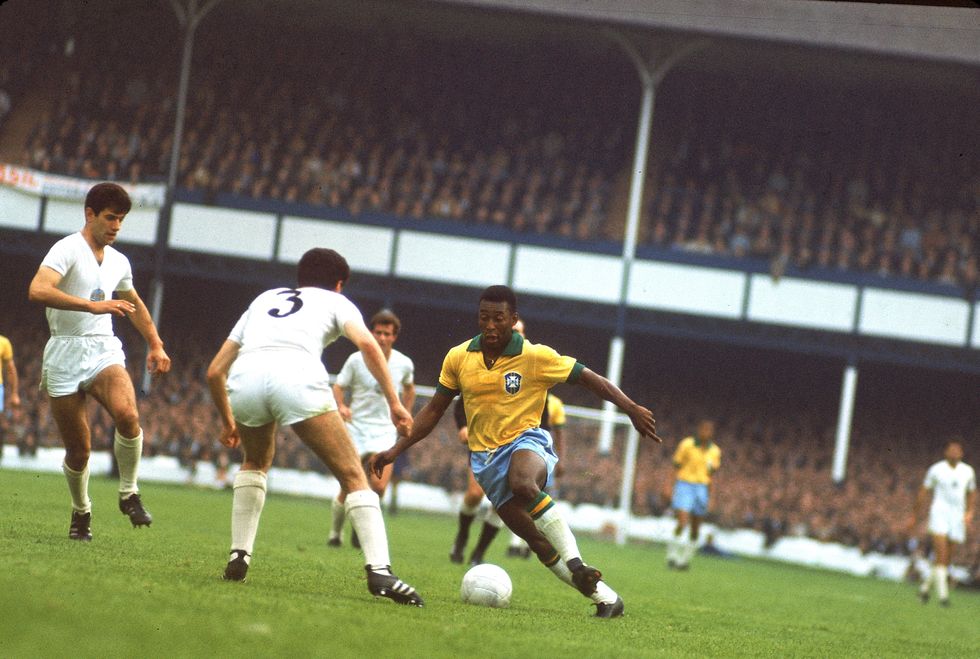
His first contract was far from lucrative
At 15 years old, Pelé signed his first contract with Santos in 1956, earning just $10 a month. According to ESPN, he used his pay to buy his mother a gas stove, though their town didn’t haven’t the capability to pipe gas into homes. Years later, he signed a three-year $7 million contract with the New York Cosmos in 1975, making him the highest‐paid team athlete in the world at the time. The New York Times estimated that $2 million of the deal went to taxes for the native Brazilian, however. “He will pay his own taxes, just like every American,” Cosmos vice president and general manager Clive Toye explained in 1975, per the newspaper.
He’s a Brazilian national treasure — literally
After Pelé led Brazil’s national team to their first World Cup win in 1958, European clubs such as Real Madrid, Juventus, Inter Milan and Manchester United began courting the rising star. In order to prevent him from being traded to foreign teams, Brazilian President Jânio Quadros eventually had Pelé declared a national treasure in 1961.
“Well, first of all it was an honor for me. But I pay income tax like anybody else,” he joked to Esquire in 2016. “I was invited — I had several proposals to play in Europe. For Real Madrid, for AC Milan, for Bayern Munich. But at that time, we didn't have too many Brazilian players outside the country. I was very happy at my team, Santos. I didn't have the desire to play outside the country.”
He held two Guinness World Records
By the end of his career, Pelé had won three FIFA World Cups with Brazil (in 1958, 1962 and 1970), earning him the most wins by any player. Of course, that’s but one of the many records he broke on the soccer field. The four goals Pelé scored in his 1956 professional debut only set the stage for the 1,283 total goals he’d go on to rack up over the years. There is some debate over Guinness’ total number, however, since multiple outlets reported that he scored more than 500 of those goals in “unofficial friendlies and tour games,” rather than in professional competition.
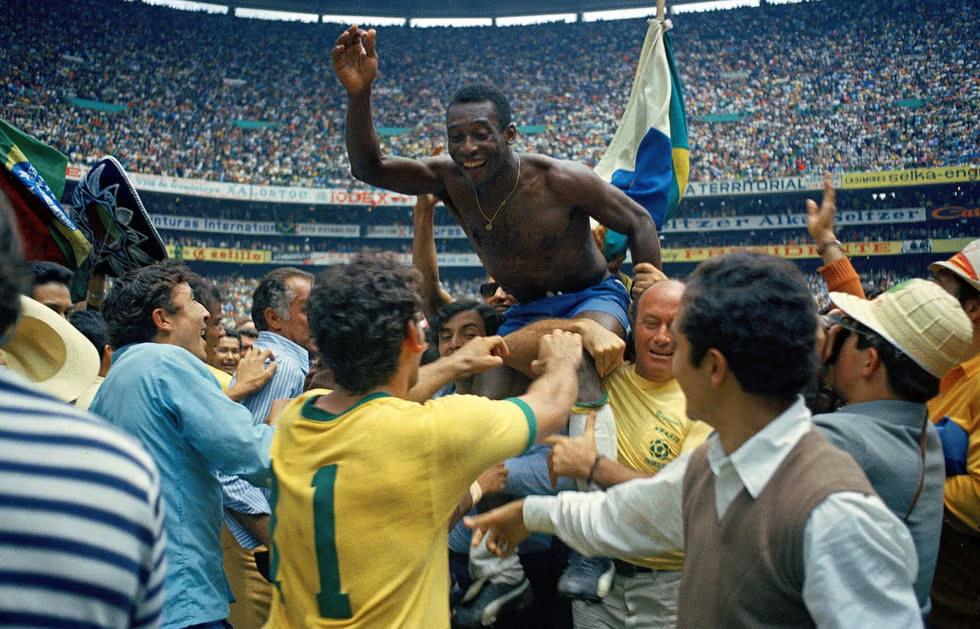
Henry Kissinger convinced him to play in the U.S.
After Pelé retired from the Brazilian national team and Santos in 1974, former Secretary of State Henry Kissinger traveled to Sao Paulo to convince him to return to gameplay for the New York Cosmos. "He invited me to go to the cafe with him, and there he said, 'Listen. You know I'm from the United States, and I'm in politics there. Soccer is coming along there-they're playing it in the schools. Would you like to help us promote soccer in the United States?'” Pelé, who didn’t speak English at the time, recalled to Esquire in 2016. “And I said, 'My God.'"
Prior to him signing a reported $7 million, three-year contract with the New York Cosmos, Kissinger reportedly sent him a telegram that read: “Should you decide to sign a contract, I am sure your stay in the United States will substantially contribute to closer ties between Brazil and the United States in the field of sports.”
He once (temporarily) stopped a war
Kissinger noted in a 1999 Time article that both sides in Nigeria’s civil war called a 48-hour cease-fire in 1967 so Pelé could play an exhibition match in the capital of Lagos. Santos' website elaborates that the region's military governor Samuel Ogbemudia declared a holiday and opened up a bridge so that both sides could watch Pelé’s 2-1 victory over Nigeria.
“We were asked to play a friendly match on Benin City, in the middle of a Civil War, but Santos was so beloved that they agreed on a ceasefire on the matchday. It became known as the day that 'Santos stopped the war,'” Pelé tweeted in 2020. (In recent years, however, some have debated the extent of the reported ceasefire.)
He was friends with Nelson Mandela
Pelé left a family holiday to play in 2007’s “ 90 Minutes for Mandela ” charity match in honor of the South African president ’s 89th birthday. During a joint press conference, Pelé awarded Mandela an autographed jersey, which the latter called a “priceless gift” he’d treasure for the rest of his life.
“He was my hero, my friend, and also a companion to me in our fight for the people and for world peace,” Pelé tweeted following Mandela’s 2013 death, also calling the leader “one of the most influential people” in his life.
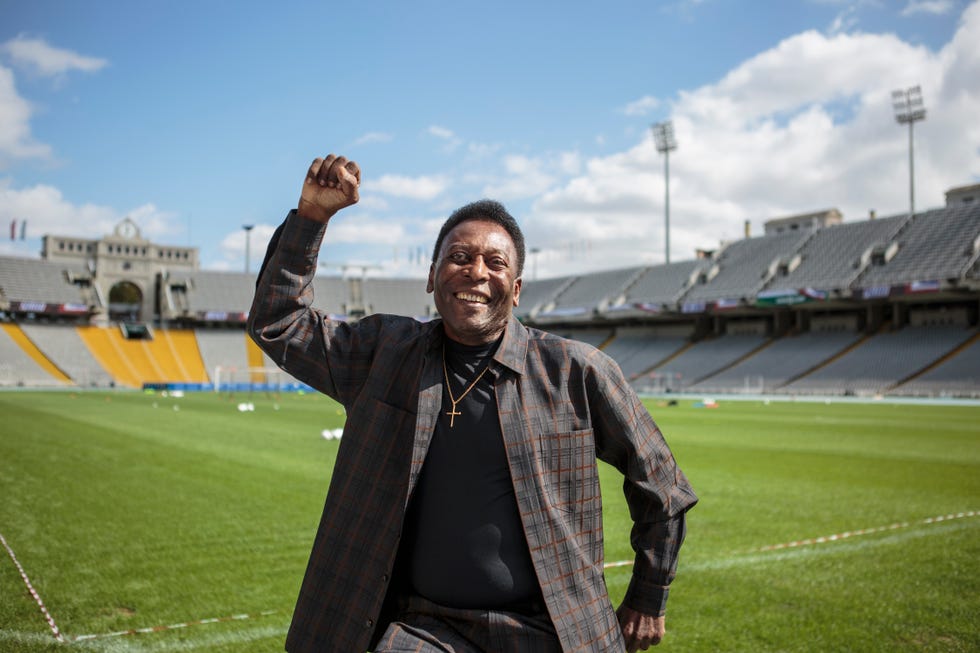
He played for both teams in his final pro game
In October 1977, Pelé competed in his final professional game in an exhibition match between the New York Cosmos and Santos F.C. in front of 77,000 spectators — including Muhammad Ali — at New Jersey’s Giants Stadium. He played the first half of the game for Santos, scoring one goal, and then switched jerseys and played for the Cosmos in the second half. The Cosmos eventually won the match with a final score of 2-1.
He was knighted by Queen Elizabeth II
Despite not being of British descent, Queen Elizabeth II bestowed upon Pelé the honorary title of Knight Commander of the British Empire (KBE) in 1997 for his humanitarian work and activism. Beginning in 1994, Pelé served as the United Nations Educational, Scientific and Cultural Organization’s Champion for Sport and a Goodwill Ambassador for UNICEF, creating such campaigns as Children in Need fundraising in 1996, and the Match of the Hearth, in 2000. “It will always stay in my memory,” he tweeted in 2020 of his honorary knighthood. “I thank all the British people for their affection.”

Black History
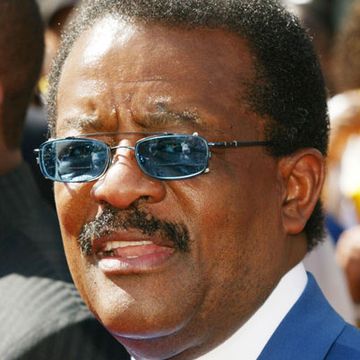
Jesse Owens

Alice Coachman

Wilma Rudolph

Tiger Woods

Deb Haaland

10 Famous Langston Hughes Poems

5 Crowning Achievements of Maya Angelou

Ava DuVernay

Octavia Spencer

Inventor Garrett Morgan’s Lifesaving 1916 Rescue
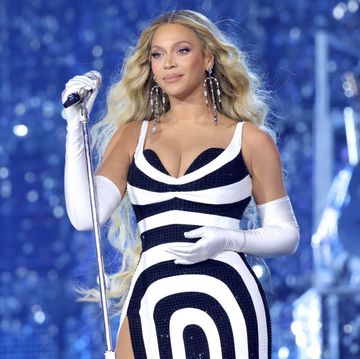
Get to Know 5 History-Making Black Country Singers
- Share full article
Advertisement
Supported by
Pelé Was Brazil’s Ambassador to the World
In leading his national team to success on the field, a soccer star helped his country find itself.

By Tariq Panja
Tariq Panja lived and worked in Brazil from 2013 to 2016.
The young soccer players who were gathered on the lush green grass of the Rose Garden were buzzing even before the president of the United States took hold of the microphone. Even the president knew they had not come to see him.
“Oh, by the way,” the president began, almost as an aside , “my name’s Ronald Reagan.” The Brazilian soccer star next to him needed no introduction.
Everyone knew Pelé.
He had met, by then, three American presidents, starting with Richard Nixon a decade earlier, and he would go on to meet several more . Each visit cemented the role of Pelé, who died on Thursday , as not just the world’s best soccer player, but as a living embodiment of his country. He was, for most of his 82 years, Brazil’s representative to the world and a source of pride to a nation that found itself, thanks in part to the magic in the feet of the 17-year-old wunderkind who fired it to its first World Cup championship in 1958.
Brazil has identified with — and been identified with — Pelé ever since. It is hard to overstate the meaning of the connection between the individual and the country, a link that endured at his death almost as strongly as it did in Pelé’s heyday, when he was among the most famous people in the world. For a country still looking to make its mark in the postwar years, Pelé’s arrival signaled Brazil’s coming-of-age.
When he arrived in Sweden for the 1958 World Cup, Pelé frequently recalled, he was surprised at how little people knew about the place that had produced him, a country he had believed to be the best in the world.
That view was not widely shared in Brazil. The nation was burdened in those days with the so-called complexo de vira-lata , a term coined by the writer Nelson Rodrigues after Brazil’s humiliation on home soil in the final game of the 1950 World Cup. That defeat, Rodrigues wrote, exemplified a collective inferiority complex Brazil saw in itself, not just in soccer but in its relationship with the rest of the world.
“Here is the truth,” Rodrigues wrote. “We can’t find personal or historical pretexts for self-esteem.”
The same writer, however, said just before the team headed to Sweden eight years later that it had finally found in its young star a figure to lift spirits and to turn Brazil into a nation of which its citizens could finally be proud.
“With Pelé on the team, and others like him, no one will go to Sweden with the souls of stray dogs,” Rodrigues wrote. “The others will tremble before us.” They did just that.
That first world championship delivered to Brazil the type of recognition it craved, and in Pelé it found a talent whose brilliance set him, and the Brazilian people, apart. Brazil’s canary yellow shirts and Pelé’s dazzling play became synonymous with the country itself, its calling cards to the world.
As Brazil won a second title in 1962, and a third in 1970, Pelé came to personify a period of sustained success on the soccer fields that was matched by an economic boom at home and the rise of bossa nova, a style of samba music from Rio de Janeiro that swept through the world like a current of electricity. Brazil’s confidence was sky high then, and in Pelé the nation had found “O Rei,” its king, a nickname that would be attached to Pelé until his last breath.
In Brazil, Pelé’s feats, successes and celebrity meant so much more given where he had come from and — whether he embraced it or not — whom he represented.
Brazil, in 1888, was the last Western country to abolish slavery, and Pelé was born just 52 years later, a poor Black child who started out life shining shoes.
His journey to national hero, after his explosion onto the global consciousness as a teenager, was particularly meaningful for Brazil’s Black population, and for its poor. His popularity also lifted him above the fray of domestic issues, soccer royalty in a nation still finding its way.
Pelé, sometimes to the frustration of activists, rarely spoke out about racism during his playing career or afterward. He would often repeat the consensus view that Brazil was in fact a “racial democracy,” a position that has been challenged with the growth of the Black consciousness movement. His refusal to take political stands also stood out in a period when Brazil was ruled by a series of dictatorships, during which Brazil’s military sought to take advantage of soccer’s popularity to sustain its hold over the country.
“I thought his behavior was that of a Black person who only said, ‘Yes sir,’ a Black person who is submissive, accepts everything,” Paulo Cézar Lima, a former teammate on the Brazilian national team, said in a 2021 Netflix documentary made with Pelé. “A single word would have meant so much in Brazil.”
Yet to some of his other compatriots, Pelé’s very presence as a globally recognized Black Brazilian was enough. Taking on a dictatorship, after all, carried risks.
Pelé’s legacy was sealed at the 1970 World Cup, a tournament in which he initially did not want to play. Brazil’s team, a double defending champion, had been eliminated in the group stage in the 1966 championship in England, with Pelé literally kicked out of the tournament by the roughhouse play of Brazil’s opponents. He was nearing 30 as the 1970 tournament neared, and he had said he had enough. Yet his country, and its military leaders, wanted him to go, and he finally buckled to the pressure and traveled to Mexico with a team few at home believed could win the title.
That it did so, in stunning style and with Pelé at its heart, brought joy to a country then living through some of the darkest years of its modern history, a time when the government of Emílio Garrastazu Médici killed and disappeared scores of its opponents and tortured thousands more.
“I am convinced that I helped Brazil a lot more with my football, with my way of being, than the politicians whose job it was to do this very thing,” a frail-looking Pelé told the Netflix filmmakers for the documentary released last year.
As Pelé’s star rose, so did that of Brazilian soccer. His team, Santos, which had given Pelé his debut at 15, became a global force. With Pelé in its ranks, it was lured to Europe for monthslong tours, where it took on — and took apart — some of Europe’s biggest clubs. Those European teams quickly came to realize what Brazil was, Pelé would say. But he always came home.
In many ways, he didn’t have a choice. Such was Pelé’s importance to the state that in 1961 a declaration in Brazil proclaimed him a “national treasure,” a designation that meant he could not be transferred to any club outside Brazil. For more than a decade after that, the declaration kept him out of the clutches of rich foreign suitors.
Even as he remained tied to Santos, though, Pelé’s fame was dovetailing with the start of modern sports sponsorship. His face adorned billboards throughout the country and beyond. His former teammates would remark that Pelé was almost as good at selling products as he was at playing soccer. He was finally able to capitalize on that fame when he moved to the United States in 1975: His three-year contract with New York Cosmos was worth $6 million, the equivalent of more than $34 million today.
Pelé was 34 by the time he started playing in the United States, and by then he represented far more than what he had to offer on the soccer field. He was effectively Brazil’s ambassador to the entire world, a man who moved in the company of celebrities and presidents , a player who could pause a civil war and then shake hands with a queen .
For Brazilians, those moments were a source of pride, each one a reminder of how a country in search of itself had finally found it through the medium of soccer, and through the brilliance of Pelé.
Tariq Panja covers some of the darker corners of the global sports industry. He is also a co-author of “Football’s Secret Trade,” an exposé on soccer’s multibillion-dollar player trading industry. More about Tariq Panja
Inside the World of Sports
Dive deeper into the people, issues and trends shaping professional, collegiate and amateur athletics..
What We Saw at Augusta: Golf enthusiasts regard a trip to the Masters as the stuff of dreams. Here are photos from this year’s tournament .
A Dizzying 3 Weeks: At times, Shohei Ohtani, baseball’s biggest star, seemed in danger of being tainted by a gambling scandal , before his longtime interpreter was charged with fraud.
A Soccer Team With Free Matches: When Paris F.C. made its tickets free, it began an experiment into the connection between fans and teams , and posed a question about the value of big crowds to televised sports.
Minor League Baseball’s Real Estate: The fight over a new stadium for the Eugene Emeralds highlights a wider challenge for cheaper alternatives to big-league live sports.
New York’s Favorite Soccer Team: Some people splurge on vacations, fancy shoes and motorcycles. A group of dozens of friends, neighbors and co-workers decided to try something better (or maybe worse): They bought a middling soccer team in Denmark .
Here Comes Padel: The sport is played with a racket on a court with a net, but watch out for those bouncing shots from the back wall. Reporters take a look at the padel scene in New York City .
Morning Rundown: Biden razzes Trump on everything but his trial, Boeing whistleblower says he wouldn't put his family in a 787, athletes criticize skimpy Olympics uniform
Pelé, Brazilian soccer legend, dies at 82
Brazilian soccer icon Pelé, regarded as the sport’s greatest player, whose wizardry on the pitch helped popularize it as “the beautiful game,” died Thursday after a yearlong bout with cancer.
His daughter confirmed the death on Instagram. “Everything we are is because of you. We love you infinitely. Rest in peace,” Kely Nascimento wrote.
The Brazilian legend , whose real name was Edson Arantes do Nascimento, helped his country win the World Cup in 1958, 1962 and 1970, and he remains the national team’s co-scoring leader, with 77 goals in 92 matches.
Brazil's current superstar, Neymar, tied him at the 2022 Qatar World Cup , scoring his 77th goal in 124 games.
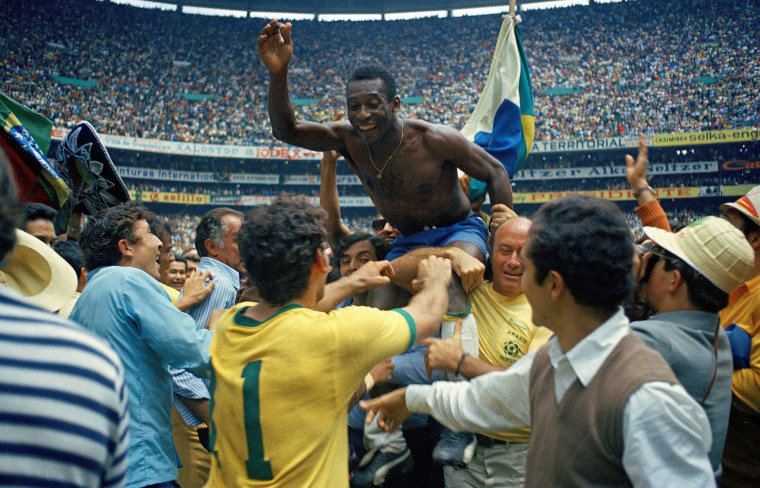
A post on Pelé’s Facebook page said he “enchanted the world with his genius in sport, stopped a war, carried out social works all over the world and spread what he most believed to be the cure for all our problems: love.”
“His message today becomes a legacy for future generations,” the post said.
Pelé became the World Cup's youngest scorer in 1958 when he bagged a goal against Wales in Stockholm at the age of 17 years and 239 days. His record still stands, and he is still the only player under 18 to have scored in a World Cup.
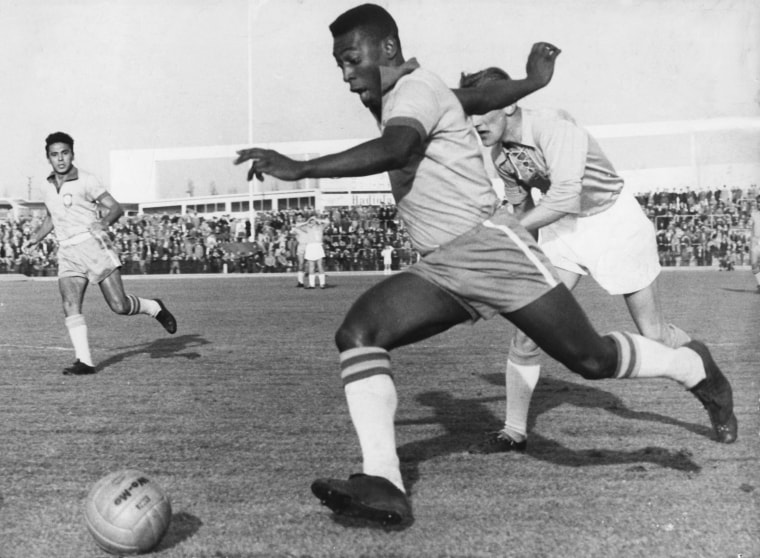
He would also help Brazil triumph in the 1962 tournament in Chile, and, after injury ruled him out of the competition four years later in England, he lit up the Mexico World Cup in 1970.
Speaking to soccer's governing body, FIFA, for Pelé's 80th birthday tribute, Tarcisio Burgnich, an Italian defender in the final that year, admitted that he had struggled against him.
“I told myself before the game, ‘He’s made of skin and bones just like everyone else,’” he said. “But I was wrong.”
Pelé's name and dominance on the pitch came to represent the sport itself.
While North Americans know the game as “soccer” and most of the globe knows it as “football,” virtually everyone agrees it’s “the beautiful game” — or “o jogo bonito” to Brazilians and Portuguese.
While the exact origins of that phrase can be debated, its popularization can be traced to the 1977 biography “Pele, My Life and the Beautiful Game” by Pelé and Robert L. Fish.
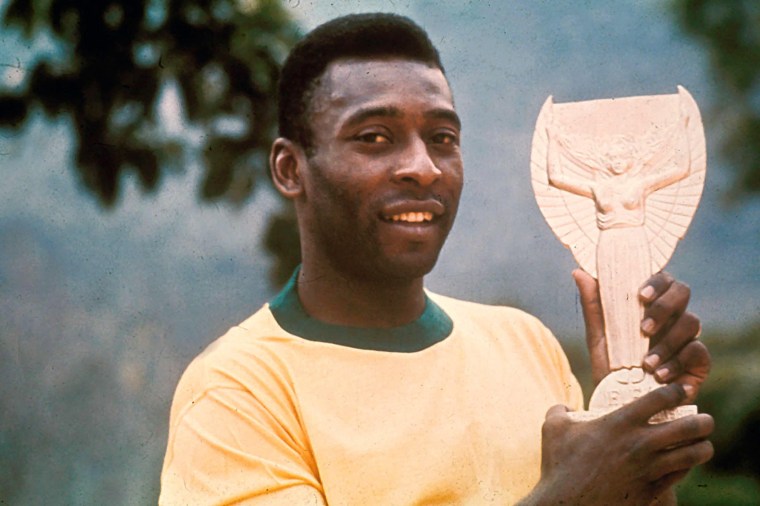
Born into poverty in Brazil’s Minas Gerais state on Oct. 23, 1940, Pelé honed his skills playing with a grapefruit before he signed with the Brazilian team Santos at age 15.
He would go on to great success with the team, winning over 20 major titles, before he signed with the New York Cosmos in the fledgling North American Soccer League in 1975.
Pelé and the Cosmos played a key role in building the sport’s U.S. profile and popularity before he closed out his professional career in 1977.
The glamorous Cosmos, led by aging stars such as Pelé, Franz Beckenbauer and Giorgio Chinaglia, won Soccer Bowl '77 and along the way attracted some of the biggest crowds that had ever seen a soccer match on U.S. soil.
Pelé's Cosmos defeated the Fort Lauderdale Strikers in a playoff match before 77,691 fans at Giants Stadium in East Rutherford, New Jersey. It was the biggest crowd to ever see an NASL match.
The Guinness Book of World Records recognizes Pelé as having scored the most goals during a specified period, with 1,279 in 1,363 games from Sept. 7, 1956, to Oct. 1, 1977.
Such was his acclaim that Pelé transcended the world of sport, becoming a recognizable figure even to those who did not follow the game. He rubbed shoulders with the likes of boxing's Muhammad Ali , Rolling Stones singer Mick Jagger and pop artist Andy Warhol , who created a portrait of him.
“Pelé was one of the few who contradicted my theory: Instead of 15 minutes of fame, he will have 15 centuries,” Warhol said.
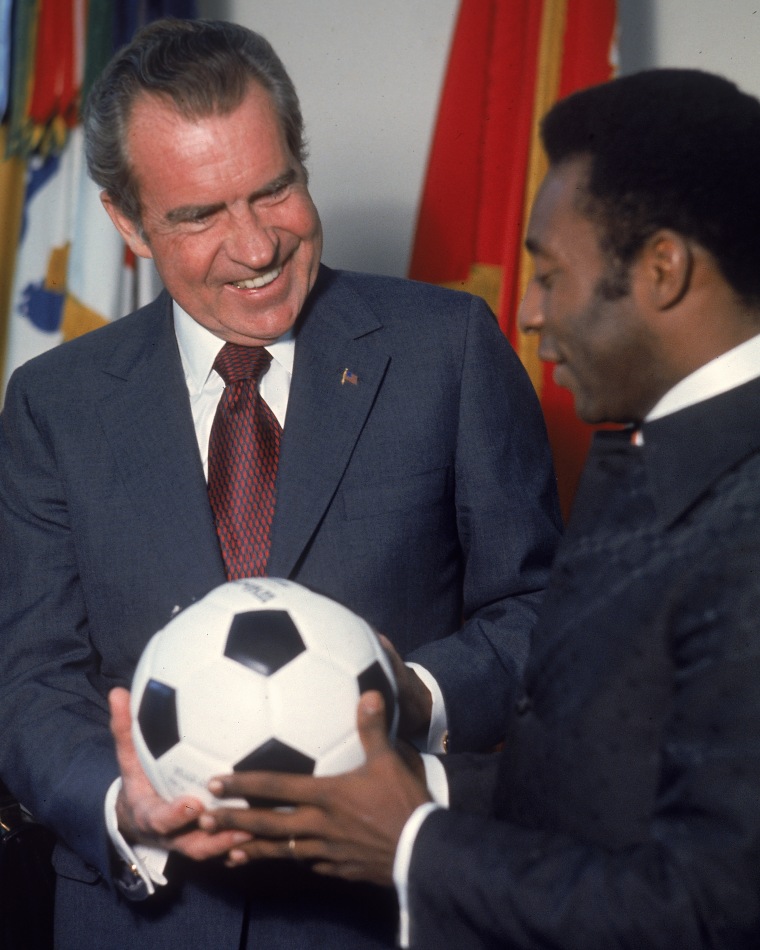
Pelé also was a regular White House visitor, gaining invitations from Presidents Richard Nixon , Gerald Ford , Jimmy Carter and Ronald Reagan .
In 1986, when Reagan invited Pelé for a state dinner in honor of Brazilian President José Sarney, he said: “My name is Ronald Reagan. I’m the president of the United States of America. But you don’t need to introduce yourself because everyone knows who Pelé is.”
After his soccer career ended, Pelé starred in several movies, including “Escape to Victory,” starring Sylvester Stallone and Michael Caine, and several documentaries about his life.
But he was perhaps best known for his ambassadorial work with the United Nations, in which he campaigned against the aggressive marketing of baby milk formulas and on environmental issues, among other causes.
In 1999, he was recognized as one of Time magazine’s “100 Persons of the Century.”
A supporter of various charities throughout his life, he set up the Pelé Foundation in 2018 to help impoverished children.
Married three times, Pelé confessed in a 2021 Netflix documentary named after him that he had so many affairs that he didn’t even know how many children he had.
His seven known offspring include Sandra Machado, whom he refused to acknowledge even after a court-ordered DNA test proved she was his daughter. She would go on to write the book “The Daughter the King Didn’t Want,” before she died in 2006 at 42.
Five other children — Kelly, 55; Edinho, 51; Jennifer, 43; and twins Joshua and Celeste, 25 — came from his first two marriages, to Rosemeri dos Reis Cholbi and Assiria Lemos Seixas. His daughter Flávia Kurtz, 53, was born to Lenita Kurtz in 1968.
In 2016, Pelé married his third wife, Márcia Cibele Aoki, whom he described as his “definitive love” on social media.
Pelé had surgery to remove a colon tumor in September 2021 and had been checking in with the Albert Einstein hospital in the Brazilian city of São Paulo every month since.
The hospital said he was admitted late last month to regulate medication for an infection.
News of his death sent shock waves throughout the sports world and beyond. Former England soccer player Gary Lineker said Pelé was the “ most divine of footballers and joyous of men ,” while Portuguese star Cristiano Ronaldo said a “mere ‘goodbye’ ... will never be enough to express the pain that the entire football world is currently embracing.”
French soccer player Kylian Mbappé said on Twitter : “The king of football has left us but his legacy will never be forgotten. RIP KING.”
Former England star Geoff Hurst said on Twitter that Pelé was "without doubt the best footballer I ever played against."
“For me Pele remains the greatest of all time and I was proud to be on the pitch with him. RIP Pele and thank you,” he tweeted.
André Ceciliano, the state deputy of Rio de Janeiro, called Pelé the “greatest Brazilian sporting idol of all time.”
“Brazil is in mourning,” he said in a tweet . “Thank you for everything.”
Former U.S. President Barack Obama tweeted: "Pelé was one of the greatest to ever play the beautiful game . And as one of the most recognizable athletes in the world, he understood the power of sports to bring people together."
"Our thoughts are with his family and everyone who loved and admired him," he said.
Mithil Aggarwal is a Hong Kong-based reporter/producer for NBC News.
David K. Li is a senior breaking news reporter for NBC News Digital.
Pele, the king of football
- Quality Automatic Automatic HD
- Speed Normal
- Subtitle Options
- Font family Default
- Font color Default
- Font opacity Default
- Font size Default
- Background color Default
- Background opacity Default
- Window color Default
- Window opacity Default
- Character edge style Default
- Monospaced Serif
- Proportional Serif
- Monospaced Sans-Serif
- Proportional Sans-Serif
- Drop Shadow
- , selected descriptions off
This is a modal window.
- Powered by THEOplayer 2023.3.0
The world of football has lost its king with the news that the great Pele passed away at the age of 82.
Pele has passed away aged 82
His death comes following a lengthy battle with cancer
With three titles to his name, the great Brazilian won more World Cups than any other player in history
Edson Arantes do Nascimento, or Pele as he was known and loved, passed away on 29 December aged 82 in Sao Paulo following a lengthy battle with cancer. He is considered by many to be the greatest footballer of all time. After several months of debilitating cancer treatment, Pele was admitted to the Hospital Israelita Albert Einstein in Sao Paulo on Wednesday 30 November with a respiratory tract infection.
In September 2021, when the Brazilian was undergoing routine examinations previously postponed due to the COVID-19 pandemic, practitioners identified a tumour on his right colon that required surgery. Since the operation, Pele had been in and out of hospital, including for chemotherapy.
Most decorated World Cup player in history Most decorated World Cup player in history
The death of Brazil’s former No10 occurred shortly after the FIFA World Cup, a tournament that propelled him to legendary status in the sport. Aged just 17, Pele was named in the Brazil squad that travelled to Sweden in 1958, playing a crucial role in A Seleção’s first ever World Cup triumph. The teenager scored six goals at that edition, including a brace in his side’s 5-2 victory over Sweden in the Final. Although still only 21, Pele was arguably at his technical peak four years later at Chile 1962, where he scored another World Cup goal. Unfortunately, a thigh muscle tear in Brazil’s second group game forced him to watch the rest of the tournament from the sidelines, as the South Americans retained their world title. Pele then went on to score his eighth World Cup goal at England 1966, a tournament that ended prematurely for A Seleção following their loss to Portugal and resulting group-stage exit. Many of his critics, including back home, thought his career was over, but he would have his redemption at his final World Cup appearance four years later. The Santos legend led an historic Auriverde side at Mexico 1970, a team that many experts regard as the greatest ever Brazilian XI. Pele scored four times at the tournament, including one in the Final against Italy at the Estadio Azteca. Brazil and Pele had claimed their record third World Cup crown, winning seven consecutive games with their famous jogo bonito. The player known as 'O Rei' ('The King') also managed to end his international career with 12 World Cup goals to his name. From that moment on, the country’s football was divided into two eras: pre- and post-Pele. Brazilians spent the following decades debating who was their next best player. Opinion is divided on whether Garrincha, Rivellino, Zico, Romario, Ronaldo, Ronaldinho or Neymar is the second-best Brazilian footballer of all time, but Pele will always be considered the greatest.
Santos, the USA and off the field Santos, the USA and off the field
Unlike many players of his generation, Pele never made the move to a big European club, instead spending most of his career at Santos. The forward played across the world with the Alvinegro and was part of their greatest ever team, winning back-to-back Copa Libertadores and Intercontinental Cups in 1962 and 1963. The footballing icon then moved to the USA, becoming one of the early driving forces behind the sport’s growing popularity in the country. Pele played for New York Cosmos between 1975 and 1977, drawing huge crowds to American stadiums. He also made a name for himself in pop culture at the time, appearing in films, art works, and even video games. And although the Mexico World Cup was his last as a player, Pele still took part in future tournaments. He worked as a commentator and served as an unofficial ambassador at USA 1994, where he saw Brazil lift the trophy for a fourth time in Pasadena, and was also present in Yokohama, Japan in 2002, when Brazil won their fifth world title, handing out the winners’ medals to his compatriots after the game. Pele’s story will always be associated with the famous yellow shirt of Brazil and the FIFA World Cup. He will also be 'The King' for all eternity.
- Election 2024
- Entertainment
- Newsletters
- Photography
- Personal Finance
- AP Investigations
- AP Buyline Personal Finance
- Press Releases
- Israel-Hamas War
- Russia-Ukraine War
- Global elections
- Asia Pacific
- Latin America
- Middle East
- Election Results
- Delegate Tracker
- AP & Elections
- March Madness
- AP Top 25 Poll
- Movie reviews
- Book reviews
- Personal finance
- Financial Markets
- Business Highlights
- Financial wellness
- Artificial Intelligence
- Social Media
Pelé, Brazil’s mighty king of ‘beautiful game,’ has died
Brazilian soccer legend Pelé has died in São Paulo at the age of 82.
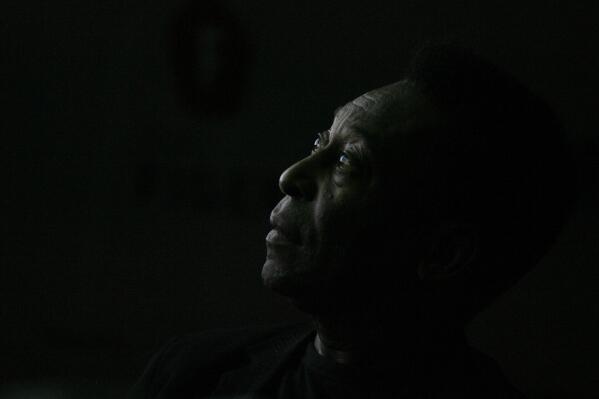
FILE - Brazil’s soccer legend Pele attends the opening of an exhibit about his life titled King’s Marks, in Brasilia, Brazil, June 25, 2008. Pelé, the Brazilian king of soccer who won a record three World Cups and became one of the most commanding sports figures of the last century, died in Sao Paulo on Thursday, Dec. 29, 2022. He was 82. (AP Photo/Eraldo Peres, File)
- Copy Link copied
FILE - Brazil’s Pele wears his national team’s jersey in Rio de Janeiro, Brazil, May 25, 1962. Pelé, the Brazilian king of soccer who won a record three World Cups and became one of the most commanding sports figures of the last century, died in Sao Paulo on Thursday, Dec. 29, 2022. He was 82. (AP Photo, File)
FILE - Brazilian soccer legend Pele smiles during a media opportunity at a restaurant in London, March 20, 2015. Pelé, the Brazilian king of soccer who won a record three World Cups and became one of the most commanding sports figures of the last century, died in Sao Paulo on Thursday, Dec. 29, 2022. He was 82. (AP Photo/Kirsty Wigglesworth, File)
FILE - Soccer star Pele, of the New York Cosmos, listens to the star-spangled banner prior to a playoff game between the Cosmos and the Rochester Lancers in Giants Stadium, East Rutherford, New Jersey, Aug. 24, 1977. Pelé, the Brazilian king of soccer who won a record three World Cups and became one of the most commanding sports figures of the last century, died in Sao Paulo on Thursday, Dec. 29, 2022. He was 82. (AP Photo/Ray Stubblebine, File)
FILE - Brazil’s Pele is hoisted on the shoulders of his teammates after Brazil won the World Cup final against Italy, 4-1, in Mexico City’s Estadio Azteca, June 21, 1970. Pelé, the Brazilian king of soccer who won a record three World Cups and became one of the most commanding sports figures of the last century, died in sao Paulo on Thursday, Dec. 29, 2022. He was 82. (AP Photo, File)
FILE - Argentine soccer star Diego Armando Maradona, left, rests in a hammock with Brazilian soccer star Pele, during a meeting in Rio de Janeiro, Brazil, May 13, 1995. Pelé, the Brazilian king of soccer who won a record three World Cups and became one of the most commanding sports figures of the last century, died in Sao Paulo on Thursday, Dec. 29, 2022. He was 82. (AP Photo/G. Copolla, File)
FILE - Brazilian soccer star Pele relaxes after a workout in Santos, Brazil, June 3, 1975. Pelé, the Brazilian king of soccer who won a record three World Cups and became one of the most commanding sports figures of the last century, died in Sao Paulo on Thursday, Dec. 29, 2022. He was 82. (AP Photo, File)
FILE - Soccer superstar Pele, waving the flags of Brazil and the U.S., is carried off the field in driving rain by players of both teams at Giants Stadium in East Rutherford, N.J., after his final game, Oct. 1, 1977. Pelé, the Brazilian king of soccer who won a record three World Cups and became one of the most commanding sports figures of the last century, died in Sao Paulo on Thursday, Dec. 29, 2022. He was 82. (AP Photo/Richard Drew, File)
FILE - Brazilian soccer legend Pele waves prior to the African Cup of Nations final soccer match between Ivory Coast and Zambia at Stade de L’Amitie in Libreville, Gabon, Feb. 12, 2012. Pelé, the Brazilian king of soccer who won a record three World Cups and became one of the most commanding sports figures of the last century, died in Sao Paulo on Thursday, Dec. 29, 2022. He was 82. (AP Photo/Francois Mori, File)
FILE - Brazil’s Pele scores past Venezuela’s goal keeper Fabrizio Fasano in Rio de Janeiro, Brazil, Aug. 24, 1969. Pelé, the Brazilian king of soccer who won a record three World Cups and became one of the most commanding sports figures of the last century, died in Sao Paulo on Thursday, Dec. 29, 2022. He was 82. (AP Photo, File)
FILE - Soccer player Pele embraces boxer Muhammad Ali during a ceremony honoring the Brazilian soccer star of the New York Cosmos at Giants Stadium, East Rutherford, N.J., Oct. 1, 1977. Pelé, the Brazilian king of soccer who won a record three World Cups and became one of the most commanding sports figures of the last century, died in Sao Paulo on Thursday, Dec. 29, 2022. He was 82. (AP Photo/Richard Drew, File)
FILE - Brazil’s soccer star Pele bicycle kicks a ball during a game at unknown location, Sept. 1968. Pelé, the Brazilian king of soccer who won a record three World Cups and became one of the most commanding sports figures of the last century, died in Sao Paulo on Thursday, Dec. 29, 2022. He was 82. (AP Photo File)
FILE - Brazil’s 17-year-old Pele weeps on the shoulder of goalkeeper Gylmar Dos Santos Neves after Brazil’s 5-2 victory over Sweden in the final of the soccer World Cup in Stockholm, Sweden, June 29, 1958. Pelé, the Brazilian king of soccer who won a record three World Cups and became one of the most commanding sports figures of the last century, died in Sao Paulo on Thursday, Dec. 29, 2022. He was 82. (AP Photo File)
FILE - Pele reacts after heading the ball during a soccer match between the Cosmos and the Toronto Metro-Croatia in New York’s Downing Stadium, June 19, 1975. Pelé, the Brazilian king of soccer who won a record three World Cups and became one of the most commanding sports figures of the last century, died in Sao Paulo on Thursday, Dec. 29, 2022. He was 82. (AP Photo/ Richard Drew, File)
FILE - Brazilian soccer star Pele waves to admirers, as he and his bride Rosemeri ride in a traditional horse-drawn carriage as they tour Salzburg, Austria, Feb. 25, 1966. Pelé, the Brazilian king of soccer who won a record three World Cups and became one of the most commanding sports figures of the last century, died in Sao Paulo on Thursday, Dec. 29, 2022. He was 82. (AP Photo/Klaus Frings, File)
FILE - Brazilian soccer star Pele and his wife Rosemeri pose for a photo with their daughter Kelly, in an unknown location, June 1967. Pelé, the Brazilian king of soccer who won a record three World Cups and became one of the most commanding sports figures of the last century, died in Sao Paulo on Thursday, Dec. 29, 2022. He was 82. (AP Photo, File)
FILE - Brazilian soccer great Pele, and English soccer star David Beckham pose for photos during a U.S. Soccer Foundation fundraising gala, in New York, March 19, 2008. Pelé, the Brazilian king of soccer who won a record three World Cups and became one of the most commanding sports figures of the last century, died in Sao Paulo on Thursday, Dec. 29, 2022. He was 82. (AP Photo/Jason DeCrow, File)
FILE - Brazilian soccer star Pele, his wife Rosemeri pose for a photo with their daughter Kelly, and newborn son Edson, in an unknown location in Brazil in 1976. Pelé, the Brazilian king of soccer who won a record three World Cups and became one of the most commanding sports figures of the last century, died in Sao Paulo on Thursday, Dec. 29, 2022. He was 82. (AP Photo File)
FILE - Brazil’s soccer legend Pele greets the crowd ahead of a Spanish league soccer match, in the Santiago Bernabeu stadium in Madrid, Jan. 16, 2005. Pelé, the Brazilian king of soccer who won a record three World Cups and became one of the most commanding sports figures of the last century, died in Sao Paulo on Thursday, Dec. 29, 2022. He was 82. (AP Photo/Jasper Juinen, File)
FILE - Brazilian soccer legend Pele is pushed in a wheelchair as he arrives at the 2018 World Cup soccer draw at the Kremlin in Moscow, Dec. 1, 2017. Pelé, the Brazilian king of soccer who won a record three World Cups and became one of the most commanding sports figures of the last century, died in Sao Paulo on Thursday, Dec. 29, 2022. He was 82. (AP Photo/Ivan Sekretarev, File)
FILE - Soccer player Neymar, left, and Brazalian soccer legend Pele, share a laugh during a centennial anniversary celebration of the team in Santos, Brazil. Pelé, the Brazilian king of soccer who won a record three World Cups and became one of the most commanding sports figures of the last century, died in Sao Paulo on Thursday, Dec. 29, 2022. He was 82. (AP Photo/Nelson Antoine, File)
FILE - Pele gives a soccer demonstration during the taping of the Johnny Carson Show at NBC-TV studios in New York, May 9, 1973. Pelé, the Brazilian king of soccer who won a record three World Cups and became one of the most commanding sports figures of the last century, died in Sao Paulo on Thursday, Dec. 29, 2022. He was 82. (AP Photo, File)
FILE - Brazilian soccer star Pele, and New York Cosmos coach Julio Mazzei, embrace at Giants Stadium in East Rutherford, N.J., April 16, 1982. Mazzei helped persuaded Pele to play in the United States and coached the Cosmos to a North American Soccer League title in 1982. Pelé, the Brazilian king of soccer who won a record three World Cups and became one of the most commanding sports figures of the last century, died in Sao Paulo on Thursday, Dec. 29, 2022. He was 82. (AP Photo/Seth Rubenstein, File)
FILE - Brazilian soccer great Pele poses with Paul Kemsley, second right, chairman of the New York Cosmos, during a press conference in Hong Kong, March 7, 2011. Pele was in here to promote the rebirth of the Cosmos, hoping for the team to begin play in 2014. Pelé, the Brazilian king of soccer who won a record three World Cups and became one of the most commanding sports figures of the last century, died in Sao Paulo on Thursday, Dec. 29, 2022. He was 82. (AP Photo/Vincent Yu, File)
FILE - Pele is carried off the Giants Stadium field by his New York Cosmos teammates after his final soccer game, in East Rutherford, New Jersey, Oct. 1, 1977. Smiling and looking up at Pele are Giorgio Chinaglia of Italy and Erol Yasin of Turkey, center. Pelé, the Brazilian king of soccer who won a record three World Cups and became one of the most commanding sports figures of the last century, died in Sao Paulo on Thursday, Dec. 29, 2022. He was 82. (AP Photo/Bill Kostroun, File)
SAO PAULO (AP) — Pelé, the Brazilian king of soccer who won a record three World Cups and became one of the most commanding sports figures of the last century, died Thursday. He was 82.
The standard-bearer of “the beautiful game” had undergone treatment for colon cancer since 2021. The medical center where he had been hospitalized for the last month said he died of multiple organ failure as a result of the cancer.
“Pelé changed everything. He transformed football into art, entertainment,” Neymar, a fellow Brazilian soccer star, said on Instagram. “Football and Brazil elevated their standing thanks to the King! He is gone, but his magic will endure. Pelé is eternal!”
A funeral was planned for Monday and Tuesday, with his casket to be carried through the streets of Santos, the coastal city where his storied career began, before burial.
Widely regarded as one of soccer’s greatest players , Pelé spent nearly two decades enchanting fans and dazzling opponents as the game’s most prolific scorer with Brazilian club Santos and the Brazil national team.
His grace, athleticism and mesmerizing moves transfixed players and fans. He orchestrated a fast, fluid style that revolutionized the sport — a samba-like flair that personified his country’s elegance on the field.
He carried Brazil to soccer’s heights and became a global ambassador for his sport in a journey that began on the streets of Sao Paulo state, where he would kick a sock stuffed with newspapers or rags.
In the conversation about soccer’s greatest players, only the late Diego Maradona, Lionel Messi and Cristiano Ronaldo are mentioned alongside Pelé.
Different sources, counting different sets of games, list Pelé’s goal totals anywhere between 650 (league matches) and 1,281 (all senior matches, some against low-level competition.)
The player who would be dubbed “The King” was introduced to the world at 17 at the 1958 World Cup in Sweden, the youngest player ever at the tournament. He was carried off the field on teammates’ shoulders after scoring two goals in Brazil’s 5-2 victory over the host country in the final.
Injury limited him to just two games when Brazil retained the world title in 1962, but Pelé was the emblem of his country’s World Cup triumph of 1970 in Mexico. He scored in the final and set up Carlos Alberto with a nonchalant pass for the last goal in a 4-1 victory over Italy.
The image of Pelé in a bright, yellow Brazil jersey, with the No. 10 stamped on the back, remains alive with soccer fans everywhere. As does his trademark goal celebration — a leap with a right fist thrust high above his head.
Pelé’s fame was such that in 1967 factions of a civil war in Nigeria agreed to a brief cease-fire so he could play an exhibition match in the country. He was knighted by Britain’s Queen Elizabeth II in 1997. When he visited Washington to help popularize the game in North America, it was the U.S. president who stuck out his hand first.
“My name is Ronald Reagan, I’m the president of the United States of America,” the host said to his visitor. “But you don’t need to introduce yourself because everyone knows who Pelé is.”
Pelé was Brazil’s first modern Black national hero but rarely spoke about racism in a country where the rich and powerful tend to hail from the white minority.
Opposing fans taunted Pelé with monkey chants at home and all over the world.
“He said that he would never play if he had to stop every time he heard those chants,” said Angelica Basthi, one of Pelé’s biographers. “He is key for Black people’s pride in Brazil, but never wanted to be a flagbearer.”
Pelé’s life after soccer took many forms. He was a politician -- Brazil’s Extraordinary Minister for Sport -- a wealthy businessman, and an ambassador for UNESCO and the United Nations.
He had roles in movies, soap operas and even composed songs and recorded CDs of popular Brazilian music.
As his health deteriorated, his travels and appearances became less frequent. He was often seen in a wheelchair during his final years and did not attend a ceremony to unveil a statue of him representing Brazil’s 1970 World Cup team. Pelé spent his 80th birthday isolated with a few family members at a beach home.
Born Edson Arantes do Nascimento, in the small city of Tres Coracoes in the interior of Minas Gerais state on Oct. 23, 1940, Pelé grew up shining shoes to buy his modest soccer gear.
Pelé’s talent drew attention when he was 11, and a local professional player brought him to Santos’ youth squads. It didn’t take long for him to make it to the senior squad.
Despite his youth and 5-foot-8 frame, he scored against grown men with the same ease he displayed against friends back home. He debuted with the Brazilian club at 16 in 1956, and the club quickly gained worldwide recognition.
The name Pelé came from him mispronouncing the name of a player called Bilé .
He went to the 1958 World Cup as a reserve but became a key player for his country’s championship team. His first goal, in which he flicked the ball over the head of a defender and raced around him to volley it home, was voted as one of the best in World Cup history.
The 1966 World Cup in England — won by the hosts — was a bitter one for Pelé, by then already considered the world’s top player. Brazil was knocked out in the group stage and Pelé, angry at the rough treatment, swore it was his last World Cup.
He changed his mind and was rejuvenated in the 1970 World Cup. In a game against England, he struck a header for a certain score, but the great goalkeeper Gordon Banks flipped the ball over the bar in an astonishing move. Pelé likened the save — one of the best in World Cup history — to a “salmon climbing up a waterfall.” Later, he scored the opening goal in the final against Italy, his last World Cup match.
In all, Pelé played 114 matches with Brazil, scoring a record 95 goals, including 77 in official matches.
His run with Santos stretched over three decades until he went into semi-retirement after the 1972 season. Wealthy European clubs tried to sign him, but the Brazilian government intervened to keep him from being sold, declaring him a national treasure.
On the field, Pelé’s energy, vision and imagination drove a gifted Brazilian national team with a fast, fluid style of play that exemplified “O Jogo Bonito” -- Portuguese for “The Beautiful Game.” His 1977 autobiography, “My Life and the Beautiful Game,” made the phrase part of soccer’s lexicon.
In 1975, he joined the New York Cosmos of the North American Soccer League. Although 34 and past his prime, Pelé gave soccer a higher profile in North America. He led the Cosmos to the 1977 league title and scored 64 goals in three seasons.
Pelé ended his career on Oct. 1, 1977, in an exhibition between the Cosmos and Santos before a crowd in New Jersey of some 77,000. He played half the game with each club. Among the dignitaries on hand was perhaps the only other athlete whose renown spanned the globe — Muhammad Ali.
Pelé would endure difficult times in his personal life, especially when his son Edinho was arrested on drug-related charges. Pelé had two daughters out of wedlock and five children from his first two marriages, to Rosemeri dos Reis Cholbi and Assiria Seixas Lemos. He later married businesswoman Marcia Cibele Aoki.
Azzoni reported from Madrid.
AP sports: https://apnews.com/hub/sports and https://twitter.com/AP_Sports

- International edition
- Australia edition
- Europe edition
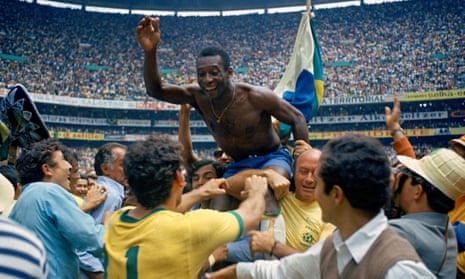
Pelé, Brazil World Cup winner and football legend, dies aged 82
- Pelé scored a world record 1,281 goals in 1,363 games
- Pelé tops our list of the top 100 all-time World Cup footballers
- Observer Archive from 1970: ‘There is only one Pelé’
Pelé, the Brazilian virtuoso whose captivating skill and athleticism ensured he was universally regarded as one of football’s greatest players, has died at the age of 82.
Pelé, who had a colon tumour removed in 2021, was readmitted to Albert Einstein hospital in São Paulo in November amid deteriorating health. A hospital statement on Thursday confirmed the death of “our dear King of Football” at 3.27pm local time, “due to the failure of multiple organs, a result of the progression of cancer of colon associated with his previous clinical condition.”
A statement from Pelé’s official Instagram page added: “Inspiration and love marked the journey of King Pelé, who peacefully passed away today. On his journey, Edson enchanted the world with his genius in sport, stopped a war, carried out social works all over the world and spread what he most believed to be the cure for all our problems: love. His message today becomes a legacy for future generations. Love, love and love, forever.”
After reports he was receiving end-of-life care, Pelé said he felt “strong, with a lot of hope” in a social media post on 3 December. A further statement from the hospital on 21 December reported that Pelé “requires further care related to renal and cardiac dysfunctions” after the “progression” of his colon cancer. Social media posts from his daughter Kely Nascimento showed that family members had gathered at the hospital to spend Christmas with him.
Brazil’s joint all-time record scorer won three World Cups as a player, in 1958, 1962 and 1970, over a 14-year international career that included 77 goals in 92 appearances for his country. Nicknamed “the Black Pearl” and “the King”, Pelé was one of only three players to have scored in four World Cups. In 1,363 games, he scored 1,281 goals, at the time of his retirement in 1977 more than twice as many as his nearest challenger.
It was the 1970 World Cup triumph for which he will be best celebrated, the linchpin of a beguiling team that included Carlos Alberto, Jairzinho, Gérson, Tostão and Rivelino that swept through Mexico, his canary yellow No 10 shirt becoming an icon of the sport.
World Soccer described Brazil’s 1970 winners as “more than a team”, adding: “The Brazilian side that won the 1970 World Cup in such style have become a myth, a team to be held up as the ultimate exponents of the beautiful game.” Pelé was their figurehead and inspiration.
Brazil’s government declared three days of mourning and the arch at Wembley Stadium was lit in the colours of Brazil, while icons of sport and heads of state bowed to the man who rose up from childhood poverty to become a legend.
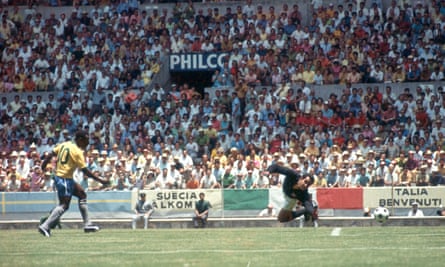
Born Edson Arantes do Nascimento on 23 October 1940, Pelé began his professional career at 15 and made his international debut a year later. In 1999, he was voted player of the century in a poll of Ballon d’Or winners and Time magazine named him as one of 100 most influential people of the 20th century.
In his prime, Pelé’s celebrity was such that he gained audiences with popes and heads of state, his allure so great that when the ill-fated New York Cosmos sought a marquee name to launch a soccer assault on America, Pelé was one of the very few footballers to be recognised by the wider American public in the 1970s.
Pelé previously underwent surgery in November 2012, having a hip replacement at a time when he was struggling to cope with life on the road, and had since suffered a urinary infection after having kidney surgery for the removal of stones.

In recent years Pelé had reduced his personal appearances, including in February 2020 when he did not attend a ceremony to unveil a statue of him representing the 1970 World Cup-winning team because of mobility problems that led to the Brazilian using walkers and wheelchairs in public.
João Saldanha, the coach who helped shape that 1970 side, once said: “Ask me who is the best right-back in Brazil, and I’ll say Pelé. Ask me about the best left-back or midfield man, or the best centre-forward. Always I must say Pelé. If he wants to be goalkeeper, he will be. There is only one Pelé.”
Brazil’s president-elect, Luiz Inácio Lula da Silva, said: “I had the privilege that younger Brazilians didn’t have: I saw Pele play, live, at Pacaembu and Morumbi. Play, no – I saw Pele give a show.
“Because when he got the ball he always did something special, which often ended up in a goal.”
Former Brazilian president Dilma Rousseff wrote: “Thank you for the joy you gave the Brazilian people and the people of the world. No one has been a king so loved.”
- Brazil (Football)
- Brazil (World news)

Private burial of Pelé in Santos after eight-mile funeral procession

Brazil president joins mourners paying tribute to Pelé before funeral

‘I had to say goodbye’: thousands pay their respects to Pelé in Brazil

Fifa’s Infantino will ask every country to name stadium in honour of Pelé

Pelé’s shimmering legend was forged in the heat of the 1970 World Cup finals

Brazil prepares to say goodbye to Pelé as it welcomes a new president

‘He will be eternal’: Premier League managers lead tributes to Pelé

Pelé dies aged 82: tributes paid to a football great

Pelé radiated the quality of joy: an instant appeal to the eye and heart

Pelé obituary
Comments (…), most viewed.

- Business persons
The Biography of Pele, No.1 Footballor around the world
Dhruba Prasad Ghimire
8 april, 2023 10:48 pm.

The biography of Pele , full name Edson Arantes do Nascimento, better known as Pelé, is considered one of the greatest football players ever.
Table of Contents
The biography of pele childhood.
Born on October 23, 1940, in Três Corações, Brazil, Pelé grew up in poverty and began playing football as a child, using a makeshift ball made of socks or rags.
He began playing for local youth teams. In 1956, at 15, he was signed by Santos FC, one of Brazil’s top football clubs. He debuted for the club in September of that year and quickly became a star player.
In 1958, at just 17, Pelé was called to the Brazilian national team for the World Cup in Sweden. He scored six goals in the tournament, including two in the final, to help Brazil win their first-ever World Cup.
Pelé’s performances in the game made him a global sensation. He quickly became one of the most famous footballers in the world.

Over the next decade, Pelé continued to play for Santos FC and the Brazilian national team, winning numerous titles and accolades.
He helped Santos win the Copa Libertadores, South America’s top club competition, three times in the 1960s and six Brazilian league titles.
He scored 1,091 goals in 1,116 official games for Santos, a remarkable achievement that earned him the Guinness Book of World Records.
Pelé’s success on the international stage continued as well. He played in three World Cups for Brazil, winning the tournament in 1958, 1962, and 1970.

He scored 12 goals in those three tournaments, including four in the 1970 final against Italy. Pelé’s performance in the 1970 World Cup is of the greatest in the history of the tournament, and he was named the player of the game.
Pelé also became a global icon off the field. He was known for his charismatic personality and his commitment to social causes.
He used his fame to advocate for peace, racial equality, and environmental protection, and he remains an influential figure today.
After retiring from football in 1977, Pelé continued to be involved in the sport as a coach and ambassador.

He has also been honored with numerous awards and honors, including being named a United Nations Ambassador for Ecology and the Environment.
Despite his many accomplishments, Pelé has faced challenges throughout his life. He has struggled with health issues, including hip and knee problems that have limited his mobility in his later years.
He has also faced criticism for his political affiliations and business dealings.
However, Pelé’s legacy as one of the greatest football players ever is secure. His skill and talent on the field, charisma, and dedication to social causes have made him an enduring icon and role model for generations of football players and fans worldwide.
People want to know about Pele on Google
Who is better, messi or pele.
Comparing Lionel Messi and Pele is difficult as they played in different eras and under other circumstances.
Pele was a dominant force in the 1950s and 1960s and helped Brazil win three World Cups. He was known for his skill, speed, and goal-scoring ability.
On the other hand, Messi has won numerous individual awards and helped Barcelona win countless domestic and international titles. He is known for his exceptional ball control, dribbling skills, and ability to score goals in almost any situation.
Ultimately, the question of who is better, Messi or Pele, is a personal opinion. While Pele may have had a more significant impact on the game during his time, Messi’s consistent excellence over the past decade has earned him a place among the greatest players of all time.
Why was Pele called Pele? Read about this in The Biography of Pele
Pele’s real name is Edson Arantes do Nascimento. He got his nickname “Pele” when he was in school, and it is said to have originated from a schoolmate who misspelled the name of a local goalkeeper named Bilé. The misspelling resulted in the word “Pele,” which stuck with Edson and became his nickname.
Later on, he legally changed his name to Edson Arantes do Nascimento, written in The Biography of Pele, but he is still commonly known as Pele, which has become a household name in the football world.
Has Pele won a World Cup? read more about it in The Biography of Pele
Yes, Pele has won the FIFA World Cup three times with Brazil. He played a significant role in Brazil’s victories in the World Cups in 1958, 1962, and 1970, scoring 12 goals in the tournament.
Pele’s performances in these World Cups are the greatest in football history, and he is considered one of the greatest World Cup players ever.
Why did Pele retire? For details, go through The Biography of Pele
Pele officially retired from professional football in 1977 at the age of 36. There were several reasons why he decided to retire.
One reason was that he played professional football for over two decades.
He had also suffered a series of injuries, including a severe knee injury in 1966, which forced him to miss a significant portion of the season.
Another reason was that he wanted to explore other interests and opportunities outside of football. He had already started pursuing a career in acting, music, and business and felt it was time to focus on these ventures.
Finally, Pele felt that he had achieved everything he could in football. He had won three World Cups with Brazil, numerous domestic and international titles with Santos, and became a global icon of the sport.
He felt it was time to leave a legacy to inspire future footballers.
Pele’s goals read in The Biography of Pele
Pele is regarded as one of the greatest footballers ever and is known for his exceptional goal-scoring ability. He scored 1281 goals in his professional career, playing for Santos, the New York Cosmos, and the Brazilian national team.
In official matches, Pele scored 757 goals in 812 appearances for Santos, making him the club’s all-time leading scorer. He scored 77 in 91 appearances for the Brazilian national team, the most memorable goal in World Cup history.
Some of his most famous destinations include his header in the 1970 World Cup final against Italy and his solo effort against England in the 1970 World Cup group stage.
Pele’s net worth is read in The Biography of Pele
Pele’s net worth is estimated to be around $100 million. Pele has earned wealth through various means, including his successful football career, business ventures, and endorsements.
During his playing days, he was one of the highest-paid footballers in the world and earned millions of dollars in endorsements and sponsorships.
After retiring from football, Pele continued to earn money through various business ventures, including his own company, Pele Sports, which sells sports equipment and apparel.
It is important to note that net worth estimates are often subject to fluctuations and may only be partially accurate due to market conditions and personal circumstances.
Pele Health know more about it in The Biography of Pele
Pele has had several health issues over the years, including hip and knee problems, and he has undergone multiple surgeries. In recent years, he has also had issues with his back, which have caused him significant discomfort and mobility issues.
In January 2021, Pele announced that he had received the COVID-19 vaccine and encouraged others to do the same. He also stated that he was in good health and continuing to take care of himself.
In February 2021, Pele’s family announced that he had undergone surgery to remove a tumor in his colon. The surgery was successful, and Pele was said to be recovering well.
He has since made public appearances and updated his health, indicating that he is feeling better and continuing to undergo treatment and rehabilitation.
Pele mother
Pele’s mother was named Celeste Arantes do Nascimento. She strongly influenced Pele’s life and career; he has spoken publicly about his deep love and respect for her.
Pelé movie, know details in The Biography of Pele
Yes. There are several movies and documentaries about Pele’s life and career. One of the most well-known is the 2016 biographical film “Pele: Birth of a Legend,” which tells the story of Pele’s rise from humble beginnings in Brazil to becoming one of the greatest footballers ever.
The film stars Kevin de Paula as a young Pele and portrays his struggles and triumphs as he overcomes poverty and racism to achieve greatness on the football field. The movie also features Rodrigo Santoro as Pele’s father, Seu Dondinho, and Vincent D’Onofrio as the coach who discovers Pele’s talent.
Other movies and documentaries about Pele include the 2004 documentary “Pele Forever,” which examines his career and impact on football, and the 2018 Netflix documentary series “The Ultimate Guide to the World Cup,” which features interviews with Pele and other football legends.
How did Pelé become famous? the facts can be found in The Biography of Pele
Pele became famous due to his exceptional talent on the football field. He began playing football as a child growing up in poverty in Bauru, Brazil, and quickly gained a reputation as a prodigy.
Pele made his professional debut for Santos at 15 and quickly established himself as one of the most talented players in Brazil. He helped Santos win several national and international titles and led the Brazilian national team to victory in the 1958 World Cup, scoring two goals in the final against Sweden.

Pele’s success on the field made him a national hero in Brazil, and he quickly became a global superstar. He was known for his speed, skill, agility, and ability to score spectacular goals. He set numerous records, scoring over 1,000 destinations in official matches.
Pele’s fame extended beyond the football field as well. He became an international ambassador for football, using his platform to promote the sport and help promote peace and understanding among nations. His talent, charisma, and humanitarian efforts have made him one of sports history’s most beloved and iconic figures.
How was Pelé influential? Find the facts in The Biography of Pele
Pele has been a hugely influential figure in football and beyond. Here are some of the ways he has had an impact:
- Elevating the status of football: Pele’s exceptional talent and success on the football field helped raise the sport’s profile, particularly in Brazil and throughout South America.
- Bridging cultural divides: Pele has used his international platform to promote peace and understanding among nations. He has worked as a global ambassador for football and has used his influence to bring people together across cultural and political divides.
- Inspiring future generations: Pele’s success story, rising from poverty in Brazil to becoming a global superstar, has inspired countless young people worldwide to pursue their dreams and work hard to achieve their goals.
- Breaking down barriers: As a Black man from a poor background, Pele faced significant racism and discrimination during his career. However, he refused to be held back by these obstacles and became a symbol of hope and perseverance for marginalized communities worldwide.
- Setting records: Pele’s incredible scoring record and numerous individual and team achievements have helped establish new standards of excellence in football and have inspired generations of players to strive for greatness.
Pele’s talent, charisma, and humanitarian efforts have made him an enduring and influential sports figure.
Who is Pelé biography? please read it in The Biography of Pele
Several authors have written biographies about Pele, one of the greatest footballers ever. Here are a few examples
- “Pele: The Autobiography” is Pele’s memoir, published in 2006. In it, he reflects on his life and career, from his childhood in Brazil to his rise to fame as a football superstar. It is also written in The Biography of Pele.
- “Pele: His Life and Times” – This biography, written by British journalist Dave Bowler and published in 1995, provides an in-depth look at Pele’s life and career, including his achievements on the football field and his impact on the sport. Pele is a lifetime hero in football, as indicated in The Biography of Pele.
- “Pele: The King of Soccer” – This biography, written by Brazilian journalist Eddy Simon and published in 2003, explores Pele’s legacy as a football icon and global sports ambassador.
- “Pele: The Greatest Footballer of All Time” – This biography, written by Luca Caioli and published in 2012, examines Pele’s rise to fame and lasting impact on football and popular culture.
There are so many biographies written about Pele. His life and career continue to inspire generations of football fans worldwide.
Is Pelé better than Messi?
It is challenging to compare Pelé and Messi directly as they played in different eras and under other circumstances. However, both are the greatest footballers of all time.
Pelé was known for his impressive athleticism, incredible speed, and accurate shooting ability. He helped Brazil win three World Cups and scored over 1000 goals throughout his career.
His contributions to the sport helped elevate football to new heights of popularity and cemented his place as a game legend.
On the other hand, Messi is known for his incredible dribbling skills, quick footwork, and goal-scoring ability. Many consider him one of his generation’s most talented and successful players.
Whether Pelé or Messi is considered “better” depends on individual preferences and opinions. Both players have had a tremendous impact on sports.
How many goals has Pelé scored?
Pele is one of the greatest footballers in football history. He has scored a remarkable number of goals throughout his career. The exact number of goals he achieved is debatable, as some goals.
However, according to the most reliable sources, Pelé scored 1,281 goals in 1,363 games throughout his career.
It includes 77 goals in 91 appearances for the Brazilian national team and 643 in 656 official club matches. These awe-inspiring statistics show Pelé’s incredible skill and longevity as a footballer.
Why was Pelé a hero? gets the facts about it in The Biography of Pele
Pele is considered a hero to many people for several reasons, both on and off the football pitch. Here are a few reasons:
- Footballing talent: People regard Pele as one of the greatest footballers ever because he won fans worldwide with his incredible skill, speed, and accuracy on the pitch.
- Three-time World Cup winner: Pele was instrumental in helping Brazil win the World Cup in 1958, 1962, and 1970. His performances in these tournaments cemented his status as a game legend.
- Sportsmanship: Pele was known for his fair play and sportsmanship on the pitch. He was never sent off in his entire career and was known for his respect for opponents and officials.
- Humanitarian work: Pele is involved in numerous charitable causes, including supporting education and healthcare initiatives for underprivileged children.
- Role model: Pele has inspired generations of footballers and fans worldwide with his talent, dedication, and sportsmanship. He has been a positive role model for millions, both on and off the pitch.
These are just a few reasons why Pele is often considered a hero. His impact on football and popular culture is immeasurable, and his legacy inspires new generations of fans and players alike.

IMAGES
VIDEO
COMMENTS
QUICK FACTS. Name: Pelé. Birth Year: 1940. Birth date: October 23, 1940. Birth City: Três Corações. Birth Country: Brazil. Gender: Male. Best Known For: A member of three Brazilian World Cup ...
Pele, Brazilian football (soccer) player, in his time probably the most famous and possibly the best-paid athlete in the world. He was part of the Brazilian national teams that won three World Cup championships (1958, 1962, and 1970). Learn more about Pele's life and career.
Edson Arantes do Nascimento (Brazilian Portuguese: [ˈɛdsõ aˈɾɐ̃tʃiz du nasiˈmẽtu]; 23 October 1940 - 29 December 2022), better known by his nickname Pelé (Portuguese pronunciation:), was a Brazilian professional footballer who played as a forward.Widely regarded as one of the greatest players of all time, he was among the most successful and popular sports figures of the 20th ...
In 1962, Pele helped Brazil to retain the World Cup, though he was injured in the early rounds, meaning he was sidelined for the knock-out stages. In 1966, Brazil were hot favourites, and Pele was the most famous and highly-rated player in the world. ... "Biography of Pele", Oxford, UK. www.biographyonline.net. Last updated 8 March 2020 ...
Legacy and life after the football career. At the time of his retirement in 1977, Pelé had amassed a series of seemingly unbreakable records. He had racked up a total of 1,283 goals in 1,363 matches, making him the top scorer in Brazilian national team history and FIFA history. Just as impressively, he managed to pull off 92 hat-tricks.
Edson Arantes do Nascimento was born on Oct. 23, 1940, in Três Corações, a tiny rural town in the state of Minas Gerais. His parents named him Edson in tribute to Thomas Edison.
For every Brazilian, Pele meant something. The older generations remembered him as a player, the younger Brazilians were told about his phenomenal skills - but he united people in this footballing ...
Santos, Brazil - A famous sports writer once said that "if Pelé had not been born a man, he would have been born a football".. Pelé - real name Edson Arantes do Nascimento - one of the ...
12/29/2022. Edson Arantes do Nascimento, better known as Pele, was a football pioneer. He has passed away at the age of 82 after a battle with cancer. Pele, a Brazilian star from the beginning ...
By Simon Smale. Posted Thu 29 Dec 2022 at 11:28am, updated Thu 29 Dec 2022 at 7:42pm. Pelé played a key role in Brazil's first three World Cup wins. (Getty Images: Alessandro Sabattini) abc.net ...
Edson Arantes Do Nascimento Pele of Brazil celebrates the victory after winnings the 1970 World Cup in Mexico match between Brazil and Italy at Estadio Azteca on 21 June in Città del Messico.
The Brazilian legend was a wizard on the field who dazzled fans, teammates and competitors alike. ... Pele's life intertwined with racial and political divides at home. One of his biographers ...
Thu 29 Dec 2022 14.59 EST. Last modified on Thu 5 Jan 2023 01.37 EST. Pelé, who has died aged 82 after suffering from cancer, is widely regarded as the greatest footballer the game has ever seen ...
After Brazil lost the 1950 World Cup final to Uruguay, a 9 or 10-year-old Edson Arantes do Nascimento, now better known as Pelé, made a promise to his devastated father. "I remember jokingly ...
By Tariq Panja. Tariq Panja lived and worked in Brazil from 2013 to 2016. Dec. 29, 2022. The young soccer players who were gathered on the lush green grass of the Rose Garden were buzzing even ...
By Mithil Aggarwal and David K. Li. Brazilian soccer icon Pelé, regarded as the sport's greatest player, whose wizardry on the pitch helped popularize it as "the beautiful game," died ...
Pele has passed away aged 82. His death comes following a lengthy battle with cancer. With three titles to his name, the great Brazilian won more World Cups than any other player in history
Sao Paulo, Brazil CNN —. Pelé, the Brazilian soccer legend who won three World Cups and became the sport's first global icon, has died at the age of 82. "Everything that we are, is thanks ...
People gathered in front of a building in São Paulo splashed with the face of Pelé. Brazil has woken up to its first day without footballing legend Pelé. "The King", who won three World Cups ...
FILE - Brazil's Pele is hoisted on the shoulders of his teammates after Brazil won the World Cup final against Italy, 4-1, in Mexico City's Estadio Azteca, June 21, 1970. Pelé, the Brazilian king of soccer who won a record three World Cups and became one of the most commanding sports figures of the last century, died in sao Paulo on ...
Brazil's joint all-time record scorer won three World Cups as a player, in 1958, 1962 and 1970, over a 14-year international career that included 77 goals in 92 appearances for his country ...
The biography of Pele, full name Edson Arantes do Nascimento, better known as Pelé, is considered one of the greatest football players ever. Fri Apr 12, 2024; ... Three-time World Cup winner: Pele was instrumental in helping Brazil win the World Cup in 1958, 1962, and 1970. His performances in these tournaments cemented his status as a game ...
Pele, arguably the greatest footballer of all time, has died at the age of 82. Brazil has declared three days of national mourning. The striker is credited with scoring a world record 1,281 goals ...